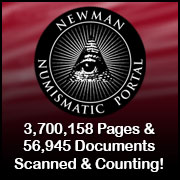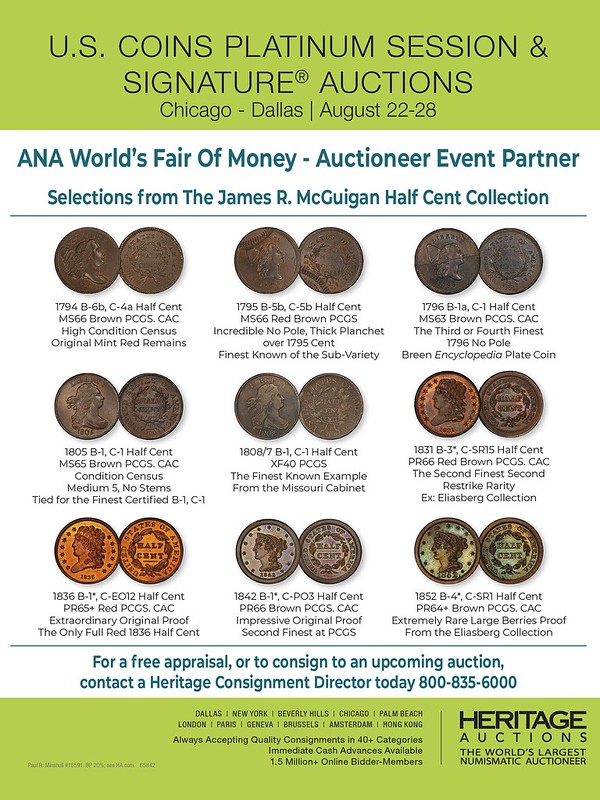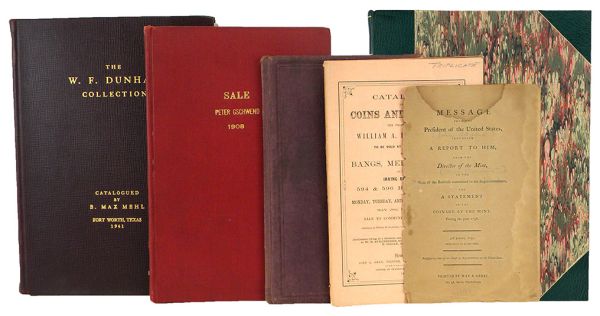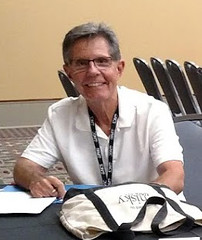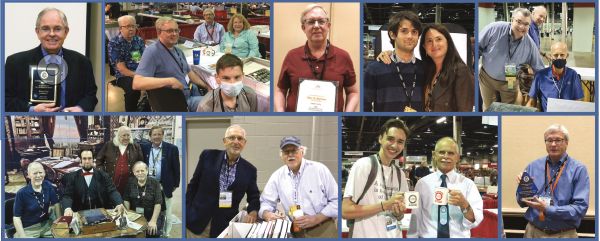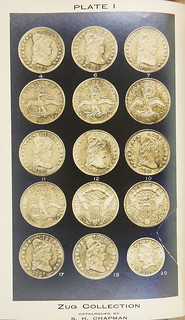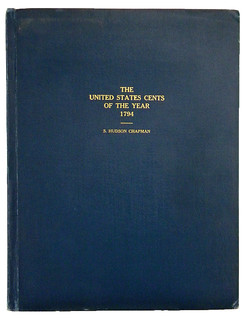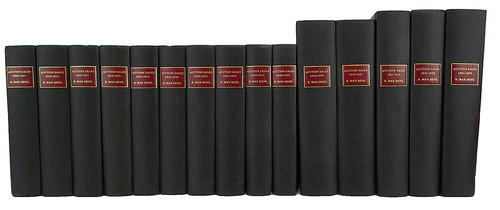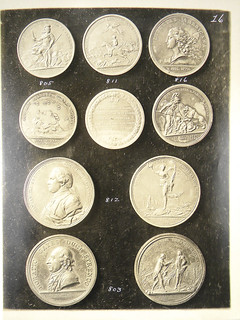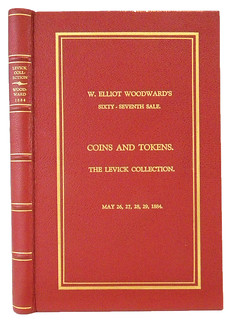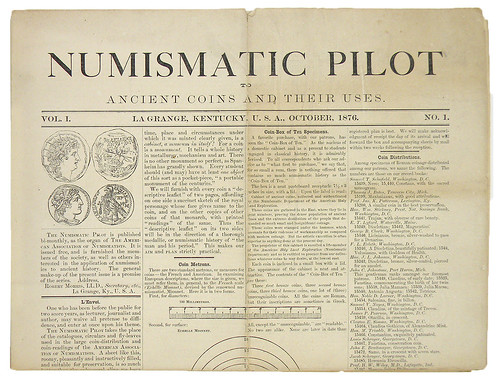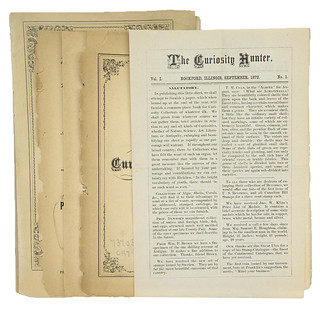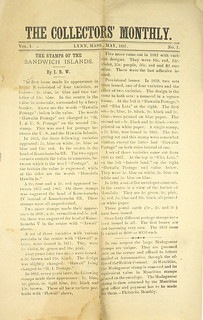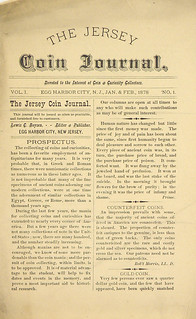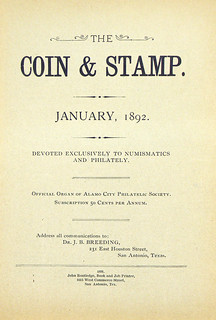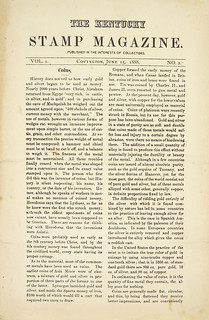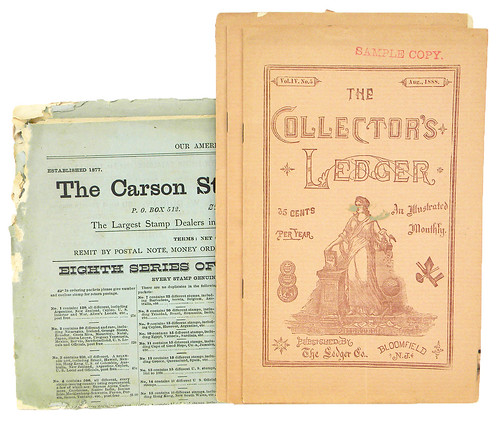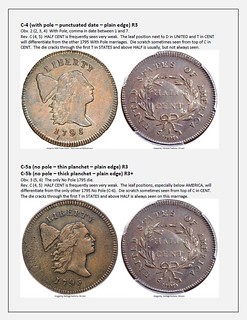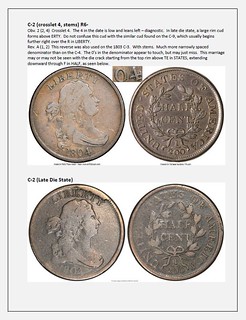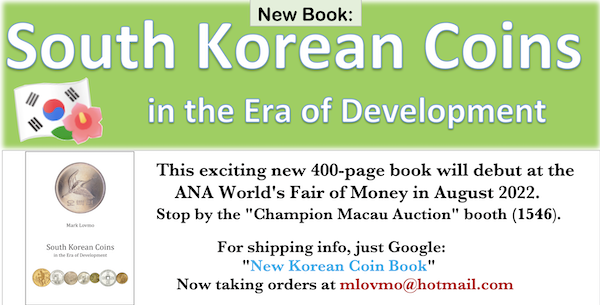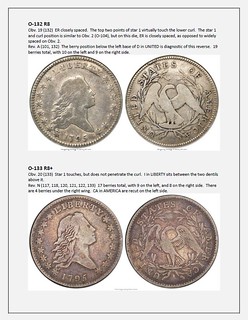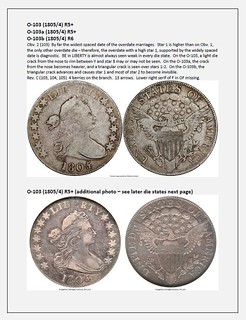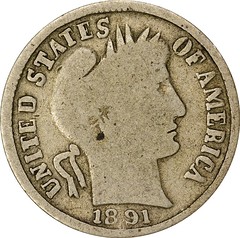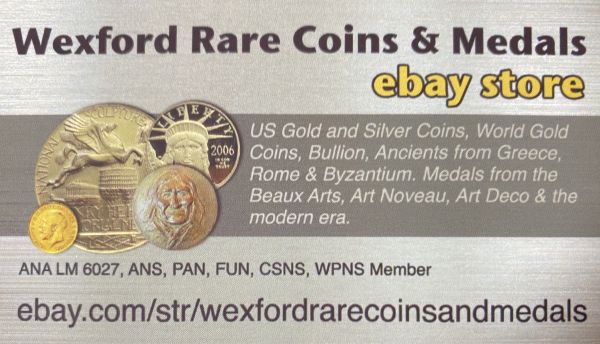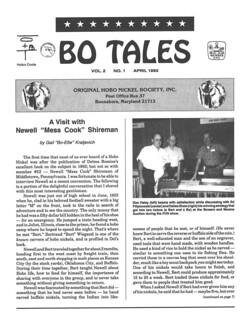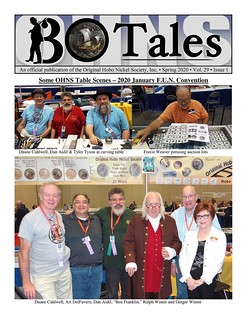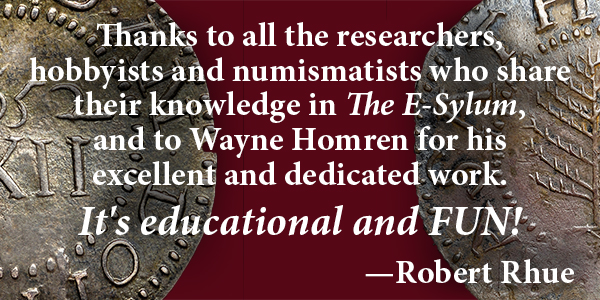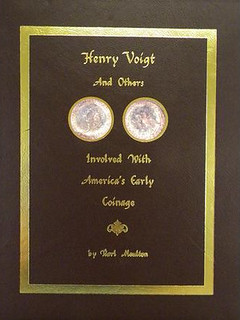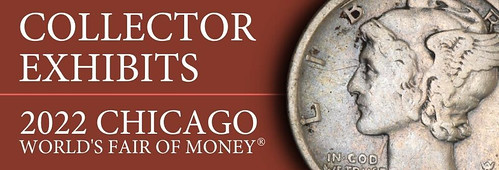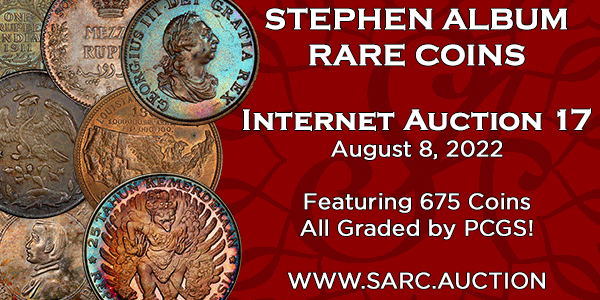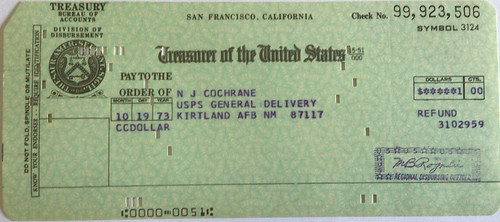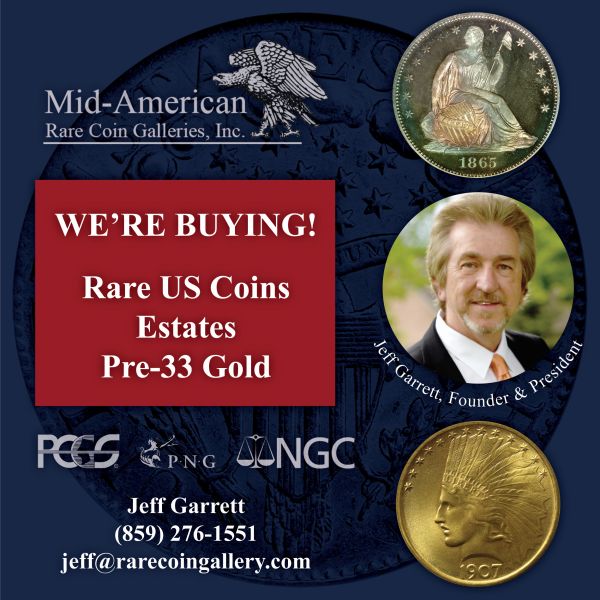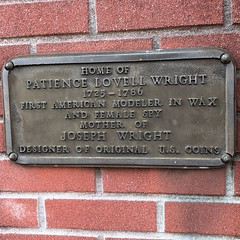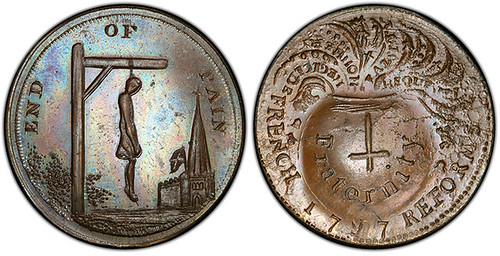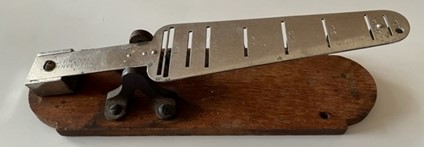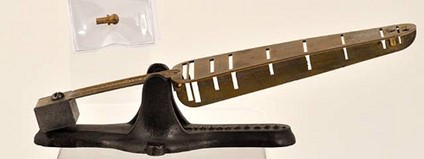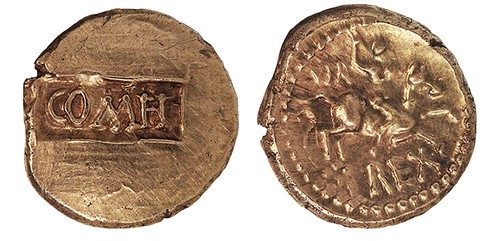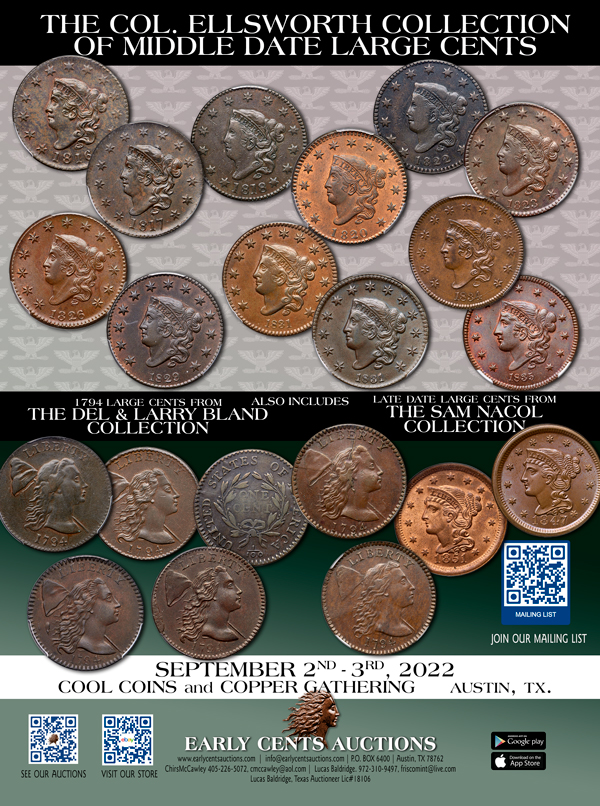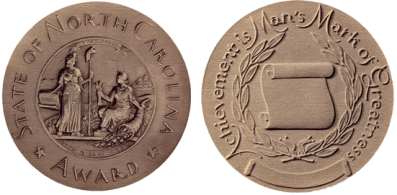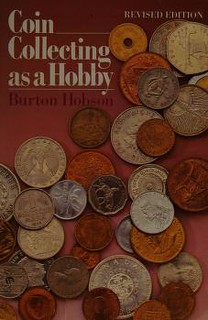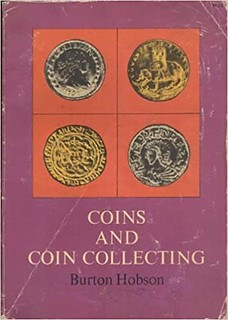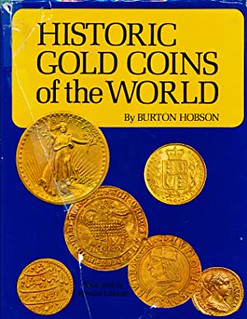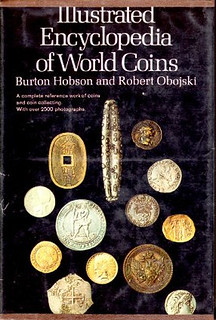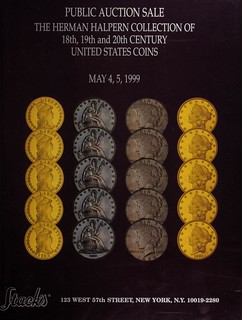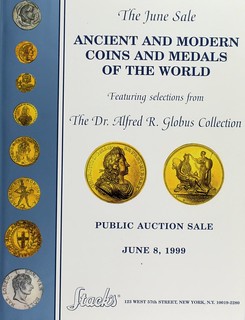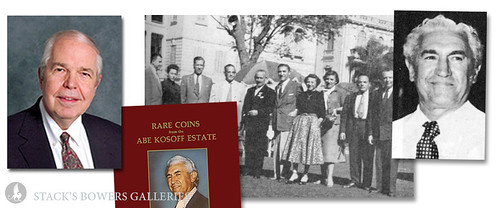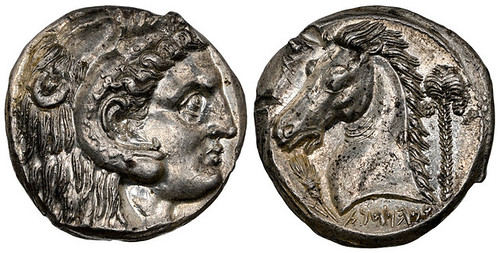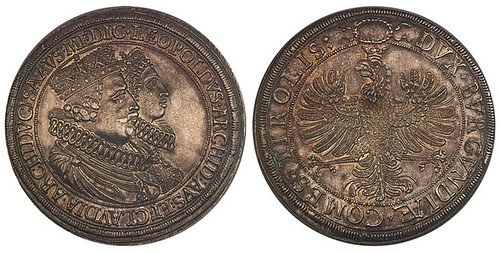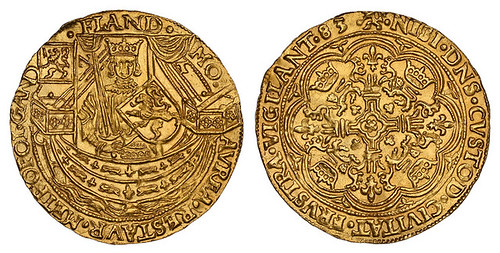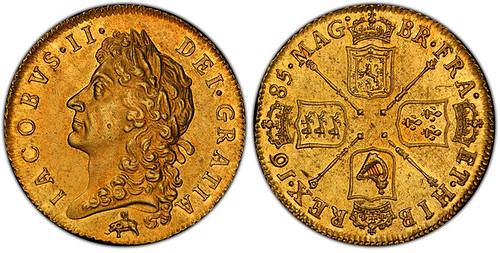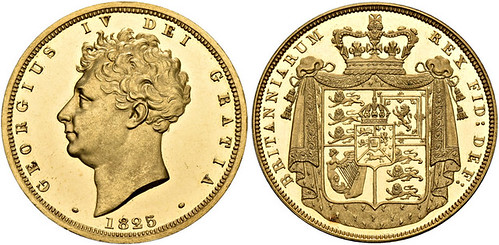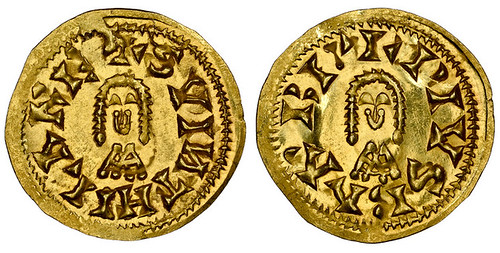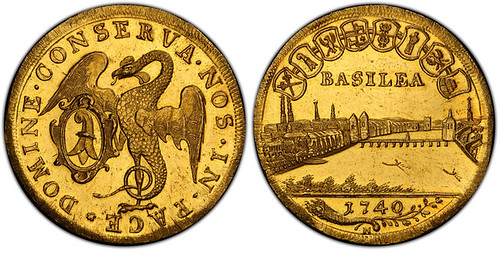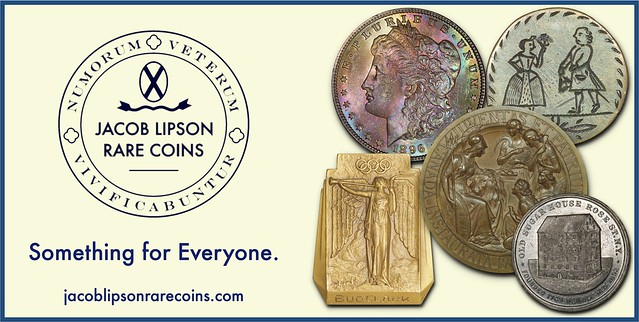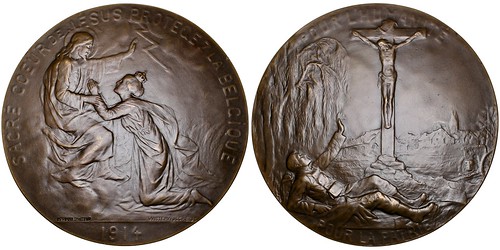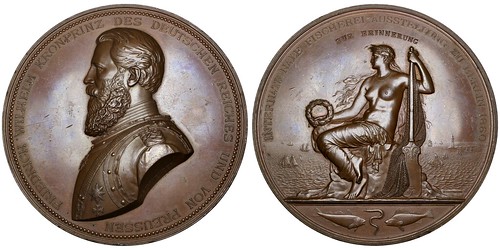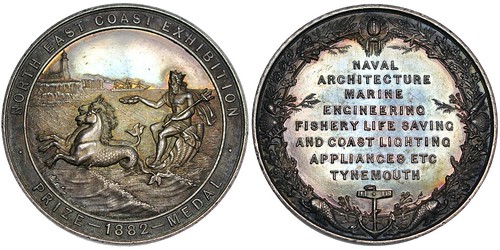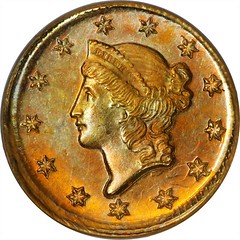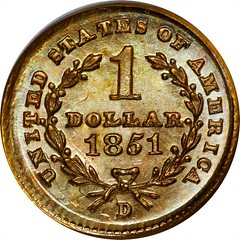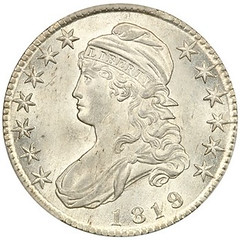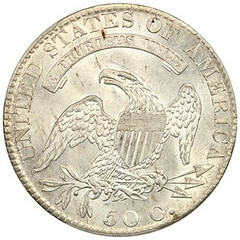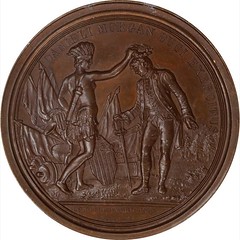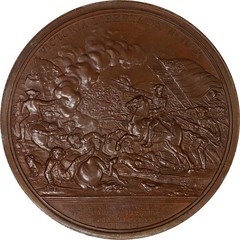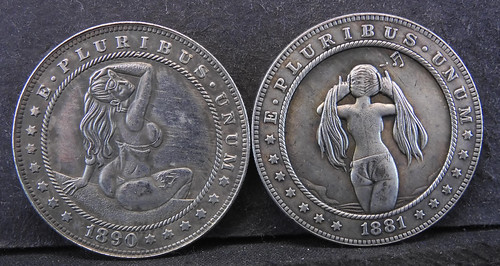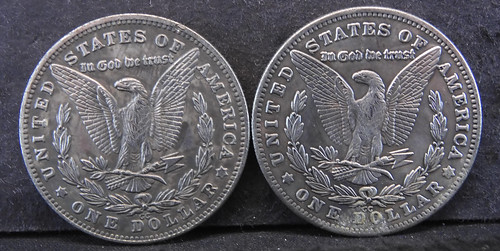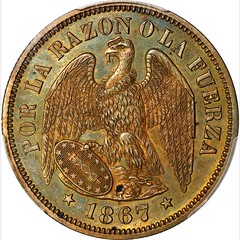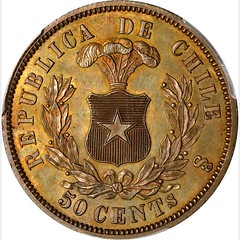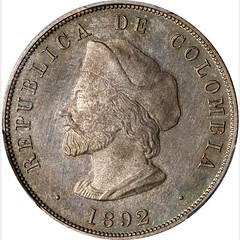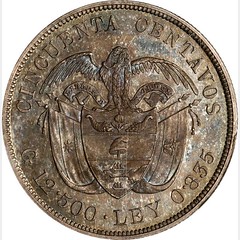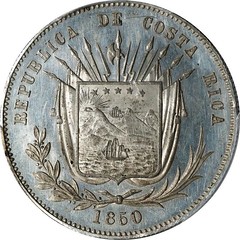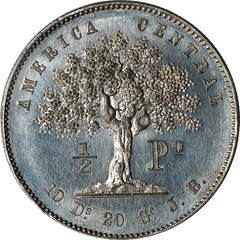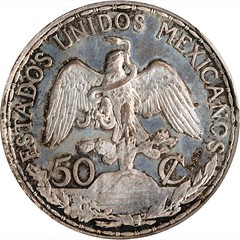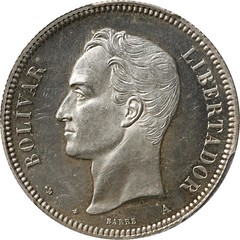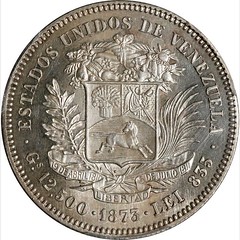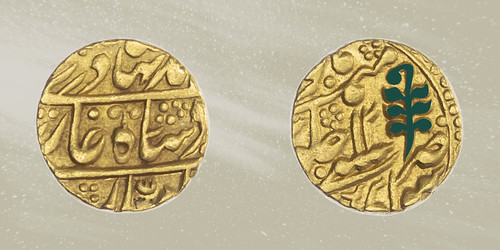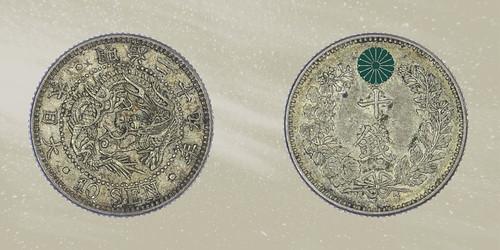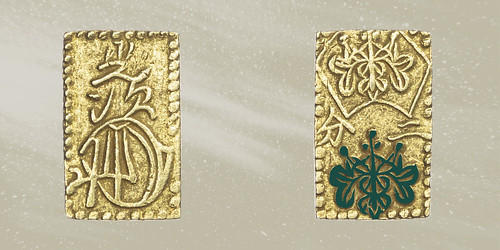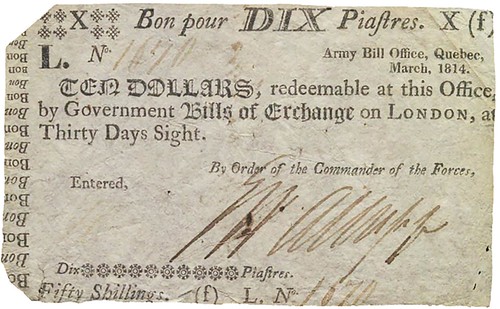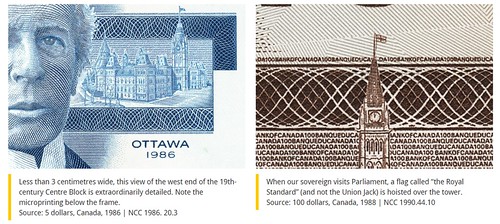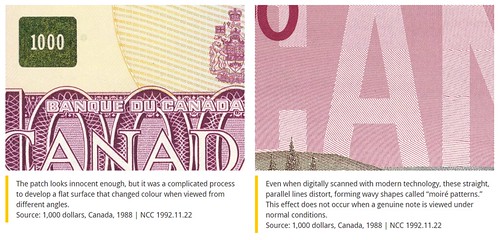
Visit our NBS Sponsors



About UsThe Numismatic Bibliomania Society is a non-profit association devoted to the study and enjoyment of numismatic literature. For more information please see our web site at coinbooks.org SubscriptionsThose wishing to become new E-Sylum subscribers (or wishing to Unsubscribe) can go to the following web page link MembershipThere is a membership application available on the web site Membership Application To join, print the application and return it with your check to the address printed on the application. Print/Digital membership is $40 to addresses in the U.S., and $60 elsewhere. A digital-only membership is available for $25. For those without web access, write to: Charles Heck, Treasurer AsylumFor Asylum mailing address changes and other membership questions, contact Chuck at this email address: treasurer@coinbooks.org SubmissionsTo submit items for publication in The E-Sylum, write to the Editor at this address: whomren@gmail.com BUY THE BOOK BEFORE THE COINSale Calendar |
- WAYNE'S WORDS: THE E-SYLUM AUGUST 7, 2022
- 2022 NBS BENEFIT AUCTION
- KOLBE & FANNING 2022 SUMMER AMERICANA SALE
- NEW BOOK: HALF CENTS 1793-1857 VARIETY GUIDE
- NEW BOOK: HALF DOLLARS 1794-1807 VARIETY GUIDE
- NEW BOOK: BAD METAL: SILVER 3 TO 25 CENTS
- NEW BOOK: PARKS IN YOUR POCKETS
- NEW BOOK: TREASURE ROOM OF THE SAKRA KING
- FALL NEW HAMPSHIRE BOOK SIGNING EVENT
- NNP ADDS ORIGINAL HOBO NICKEL SOCIETY
- VIDEO: MAY 2022 PAN COIN SHOW BANQUET
- DELUXE EDITIONS OF MOULTON BOOK ON VOIGT
- 1785 CONTINENTAL DOLLAR SALE IN NUREMBERG
- NEWSLETTER EDITORS GROUP TO MEET AT ANA
- COLLECTOR EXHIBITS AT THE 2022 CHICAGO ANA
- NOTES FROM E-SYLUM READERS: AUGUST 7, 2022
- JOSEPH WRIGHT OF BORDENTOWN, NEW JERSEY
- MCNALLY FAIRBANKS COIN SCALES
- ANTIQUARIAN BOOKS IN NUMISMATIC STUDIES
- VOCABULARY TERM: LETTERING
- BURTON HAROLD HOBSON
- HARVEY STACK'S NUMISMATIC FAMILY, PART 127
- DEALER ABE KOSOFF
- ATLAS NUMISMATICS AUGUST 2022 SELECTIONS
- NUMISMAGRAM MEDAL SELECTIONS: AUGUST 7, 2022
- NUMISMATIC NUGGETS: AUGUST 7, 2022
- PATTERN COINS OF CENTRAL AND SOUTH AMERICA
- THE MEANING OF PLANTS ON WORLD COINS
- CANADA'S ARMY BILLS: FUNDING THE WAR OF 1812
- THE BIRDS OF CANADA BANK NOTES
Click here to read the thin version on the web
Click here to subscribe
Click here to access the complete archive
To comment or submit articles, reply to whomren@gmail.com
Content presented in The E-Sylum is not necessarily researched or independently fact-checked, and views expressed do not necessarily represent those of the Numismatic Bibliomania Society.
WAYNE'S WORDS: THE E-SYLUM AUGUST 7, 2022
 New subscribers this week include:
Clifford Cooper.
Welcome aboard!
New subscribers this week include:
Clifford Cooper.
Welcome aboard!
Thank you for reading The E-Sylum. If you enjoy it, please send me the email addresses of friends you think may enjoy it as well and I'll send them a subscription. Contact me at whomren@gmail.com anytime regarding your subscription, or questions, comments or suggestions about our content.
This week we open with two numismatic literature sales, five new books, updates from the Newman Numismatic Portal, and more.
Other topics this week include Hobo Nickels, circulating counterfeit coins, new thoughts on the Continental Dollar, announcements for the upcoming ANA convention, coin scales, Burt Hobson, Harvey Stack, Abe Kosoff, auction and fixed price highlights, pattern coins of South and Central America, plants on coins, and Canada's Army Bills.
To learn more about the first six volumes of The Numismatist, the Numismatic Pilot, national park quarters, Tom Uram, Joseph Reakirt, Joseph Wright, the Invisible Coinage of Verica, coin and medal lettering, the Ghent Imitation Noble, the Saviours of Liberty medal, and the the Birds of Canada bank note series, read on. Have a great week, everyone!
Wayne Homren
Editor, The E-Sylum
2022 NBS BENEFIT AUCTION
Every year at the ANA convention, our sponsor NBS holds an auction of donated material to raise funds for the club. Bidding is open to all, and you needn't attend in person. Check out the catalog - there is some great material here, thanks to our generous donors. Pitch in as a generous bidder! -Editor
Each year at the ANA World's Fair of Money, the Numismatic Bibliomania Society conducts a charity auction to raise funds for the organization. All items sold are donated to the NBS by members and 100% of the proceeds go to the NBS treasury.
Absentee bids due by close of day Thursday, August 18 Absentee bids should be sent to David Fanning at df@numislit.com by the end of Thursday, August 18.
The sale will take place on Friday, August 19 as part of the NBS General Meeting, to be held in Room 12 from 11:30 a.m. to 1:30 p.m. Please read the terms of sale before bidding.
Thank you for your support of the NBS!
To view the Benefit Auction Catalogue, see:
https://mcusercontent.com/5c68a72f4948c463818f613c2/files/c7279743-ce57-c0ea-fc8d-b48ae2f6e30d/NBSAuction2022.pdf
Don't forget about all the other NBS events at the convention. Stop by the club table to chat with officers and fellow members. -Editor
NBS Symposium and General Meeting
Chuck Heck will speak about his new book
Die States of 1794 United States Large Cents
Thursday, August 18 at 1:00PM (Room 11)
NBS General Meeting and
Charity Auction
Friday, August 19 at 11:30AM (Room 12)
Email your photos and stories from the ANA World's Fair of Money to nbsasylum@gmail.com by September 1 for inclusion in our next Asylumissue.
For more information about the Numismatic Bibliomania Society, see:
https://www.coinbooks.org/
KOLBE & FANNING 2022 SUMMER AMERICANA SALE
Kolbe & Fanning are holding a Summer Americana sale of numismatic literature. Here's the announcement. Great material! -Editor
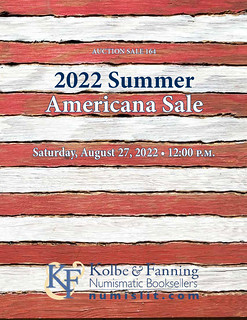 Kolbe & Fanning Numismatic Booksellers are happy to announce that we will be holding a Summer Americana sale on Saturday, August 27, 2022. The sale features highlights from the Cardinal Collection Library of American numismatic auction catalogues, the Bourne Library of U.S. numismatic periodicals, and a number of other important American works on coins and related subjects. While the focus of the sale is on Americana, this includes American items featuring ancient and foreign coins, making for a sale that includes something for everybody.
Kolbe & Fanning Numismatic Booksellers are happy to announce that we will be holding a Summer Americana sale on Saturday, August 27, 2022. The sale features highlights from the Cardinal Collection Library of American numismatic auction catalogues, the Bourne Library of U.S. numismatic periodicals, and a number of other important American works on coins and related subjects. While the focus of the sale is on Americana, this includes American items featuring ancient and foreign coins, making for a sale that includes something for everybody.
Some highlights of the sale include:
Lot 6: the first six volumes of The Numismatist, one of the true landmarks in American numismatic literature
Lot 115: the very rare plated version of S.H. Chapman's catalogue of the Charles Gordon Zug collection, one of only six copies we have traced with plates
Lot 137: the 1923 first edition of S.H. Chapman's The United States Cents of the Year 1794, one of the rarest books on U.S. large cents
Lot 189: Tom Elder's 1920 catalogue of the Henry Miller collection, with 28 superb photographic plates depicting Roman, English and American coins, in the original binding
Lot 202: a complete set of Ed Frossard's informative and entertaining periodical Numisma, from the library of George & Melvin Fuld
Lots 236 and 237: the extraordinary photographic records of the Colonel E.H.R. Green collections of United States half eagles and eagles, one of the finest collections ever formed
Lot 310: a complete set of B. Max Mehl auction catalogues, handsomely bound in 15 matching volumes
Lot 345: the deluxe plated 1925 W.W.C. Wilson catalogue, Wayte Raymond's most important sale, with 45 exceptional full-page photographic plates of coins, tokens and medals
Lot 503: W. Elliot Woodward's 1884 catalogue of the J.N.T. Levick sale, with four photographic plates, bound in full red morocco and hand-priced in ink
The Bourne Library of American numismatic periodicals, the basis for Remy Bourne's book on the subject, and featuring nearly 100 lots of rare and obscure titles, is sprinkled throughout the sale. Many of these titles are being made available through us for the first time, including dozens of 19th-century titles that are almost completely forgotten today.
Register early to bid online
Bids may be placed via post, email, fax or phone, as well as online. Kolbe & Fanning use Auction Mobility as our third-party online bidding platform. Auction Mobility is an app-based platform allowing users the ability to participate in the sale through phones, tablets and computers. To register for the sale, bidders must go to bid.numislit.com and sign up. Once you have set up an account, you may browse lots, place advance bids, or participate in the live sale online. Those wishing to participate on their devices can download the Kolbe & Fanning app through the Apple or Google Play Store. The sale will also be listed on Biddr and NumisBids in the near future.
The printed catalogue of the Summer Americana sale will soon be mailed to all active customers on our mailing list. As international mail speeds have been inconsistent, we encourage our foreign clients to consult the electronic catalogue in case their printed catalogue does not arrive promptly. A PDF of the printed catalogue has been posted to our main website at numislit.com for those who prefer that format. Bids placed via post, email, fax or phone must be received by August 26, the day before the sale, in order for them to be processed. Advance absentee bids may also be placed at any time online at bid.numislit.com. Live internet bidding will be available during the sale itself through the same platform.
Kolbe & Fanning Numismatic Booksellers LLC is a licensed and bonded auction firm in the State of Ohio. For more information, please see the Kolbe & Fanning website at numislit.com or email David Fanning at df@numislit.com. To register for the sale, go to bid.numislit.com. We look forward to your participation.
NEW BOOK: HALF CENTS 1793-1857 VARIETY GUIDE
Robert Powers has published a new variety guide for U.S. Half Cents. Like his earlier books, it is available through David Kahn Rare Coins. The book is $95, plus $5 shipping (per order, not per book). -Editor
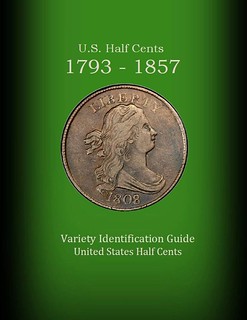 Proudly presented to you is the third volume of a new series of variety identification guides for Early American Copper coins. This volume follows Volumes One and Two (Early and Middle Date Large Cents), and covers all of the Cohen varieties for the entire Half Cent series, 1793-1857.
Proudly presented to you is the third volume of a new series of variety identification guides for Early American Copper coins. This volume follows Volumes One and Two (Early and Middle Date Large Cents), and covers all of the Cohen varieties for the entire Half Cent series, 1793-1857.
Inside, you will find a collection of the highest quality, full color, high resolution modern photos available anywhere, which will make attributing your Half Cents easier than ever before. Careful attention to detail was considered in the selection of these photos for only those which show the greatest of useful detail in helping with your attribution.
You will also find die state photos and information inside, whether the die state is important to making the coin easier to attribute or is important from a monetary value standpoint.
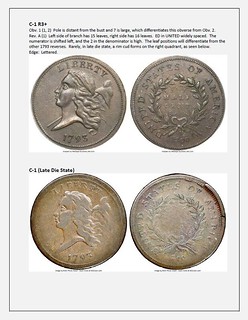 This guide is written in classical attribution guide format, meaning that you are simply presented with a photo and description of each die. There are no complicated flow charts or confusing ‘step by step' methods to slow you down. The descriptions of each die are in plain English, designed for those who are complete beginners, as well as those with an intermediate and advanced level of knowledge.
This guide is written in classical attribution guide format, meaning that you are simply presented with a photo and description of each die. There are no complicated flow charts or confusing ‘step by step' methods to slow you down. The descriptions of each die are in plain English, designed for those who are complete beginners, as well as those with an intermediate and advanced level of knowledge.
Attributing Half Cents begins with taking in the whole picture of the coin. The position of all of the features relative to the other features on each individual coin should be taken in the same way that one recognizes the face of a familiar person. The positions of the stars, leaves, letter and number spacing, etc. are universal observations for every attribution. The descriptions will point out specific and unique or semi-unique features found on each and every die to further guide you. Also, the best kept secret in variety attribution are the dentil alignments relative to the stars and letters below them. Use the dentils as your compass. Once you dive in, you will understand this ‘compass concept' all too well.
Good Luck!
I've seen the book, and like the earlier works, the images are large size and high resolution. -Editor
For more information, or to order, see:
U.S. Half Cents 1793-1857 Variety Identification Guide, by Robert Powers
(https://www.davidkahnrarecoins.com/u-s-half-cents-1793-1857-variety-identification-guide-by-robert-powers.html)
To read the earlier E-Sylum articles, see:
NEW BOOK: 1793-1795 LARGE CENT VARIETY GUIDE
(https://www.coinbooks.org/v23/esylum_v23n15a05.html)
NEW BOOK: LARGE CENT 1793-1814 VARIETY GUIDE
(https://www.coinbooks.org/v23/esylum_v23n50a02.html)
NEW BOOK: HALF DOLLARS 1794-1807 VARIETY GUIDE
Robert Powers also published a new variety guide for early U.S. Half Dollars, and it is available through David Kahn Rare Coins for $95 each, plus $5 shipping (per order, not per book). The images are large size and high resolution. -Editor
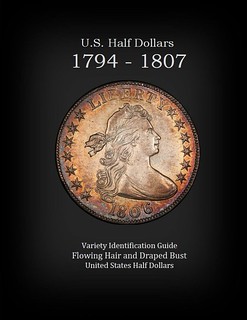 Proudly presented to you is the 4th Volume of a series of variety identification guides covering Early U.S. Coins. This volume follows Volumes 1 and 2 (Early and Middle Date Large Cents), Volume 3 (Half Cents), and covers all of the Overton varieties for the entire Flowing Hair series (1794-1795), as well as the Draped Bust series (1796-1807) of Early U.S. Half Dollars. This volume also precedes a guide for Capped Bust Halves.
Proudly presented to you is the 4th Volume of a series of variety identification guides covering Early U.S. Coins. This volume follows Volumes 1 and 2 (Early and Middle Date Large Cents), Volume 3 (Half Cents), and covers all of the Overton varieties for the entire Flowing Hair series (1794-1795), as well as the Draped Bust series (1796-1807) of Early U.S. Half Dollars. This volume also precedes a guide for Capped Bust Halves.
The primary purpose of this guide is rapid variety identification – while other publications are excellent for inviting in depth home study, this guide is perfect for portability, heavy on-the-go usage, and quick attribution.
The author of this book has had a strong interest in Early U.S. coins for over 30 years. He set out to write this series of books because he has wanted to read them for many years, and finally gave up on waiting for someone else to write them.
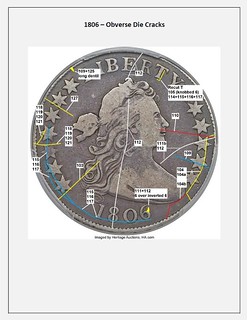 Inside, you will find a comprehensive collection of the highest quality, full color, high resolution modern photos available anywhere, which will make attributing your Early Half Dollars easier than ever before. Careful attention to detail was considered in the selection of these photos for only those which show the greatest of useful detail in helping with your attribution and die stage recognition. This guide is written in a classical, though modernized attribution guide format, meaning that you are simply presented with a photo and description of each die. The descriptions of each die are in plain English, designed for those who are complete beginners, as well as those with an intermediate and advanced level of knowledge.
Inside, you will find a comprehensive collection of the highest quality, full color, high resolution modern photos available anywhere, which will make attributing your Early Half Dollars easier than ever before. Careful attention to detail was considered in the selection of these photos for only those which show the greatest of useful detail in helping with your attribution and die stage recognition. This guide is written in a classical, though modernized attribution guide format, meaning that you are simply presented with a photo and description of each die. The descriptions of each die are in plain English, designed for those who are complete beginners, as well as those with an intermediate and advanced level of knowledge.
Attributing Bust Halves (or any coin series) begins with taking in the whole picture of the coin. The position of all of the features relative to the other features on each individual coin should be visually taken in the same way that one recognizes the face of a familiar person. The positions of the stars, leaves, berries, letter and number spacing, etc. are universal observations for every attribution. The text descriptions will point out specific, unique features found on each and every die to further guide you. Also, the best kept secret in variety attribution are the dentil alignments relative to the stars and letters below them. Every effort was made to present photos with maximum dentil visibility for this underrated purpose. Use the dentils as your compass. Once you dive in, you will understand this ‘compass concept' all too well.
On the pages immediately following, you will find enlarged photos of the 1794, 1795, 1805, and 1806 (the most complex years to attribute) with augmented lines drawn which represent the location of die cracks and other features found in various die stages on the respective marriage. If you find a die crack on a coin, you will be able to very quickly turn to the page of that die marriage to further confirm the attribution. Note that in this volume (unlike in
Volume 1 Early Date Large Cents) there is no purpose to the various colors of the lines drawn except to make it easy to tell one die crack from another.
Good luck!
For more information, or to order, see:
U.S. Early Half Dollars 1794 - 1807 Variety Identification Guide, by Robert Powers
(https://www.davidkahnrarecoins.com/u-s-early-half-dollars-1794-1807-variety-identification-guide-by-robert-powers.html)
NEW BOOK: BAD METAL: SILVER 3 TO 25 CENTS
Winston Zack's 2019 book on circulating contemporary counterfeit coins covered copper and nickel coins. It was the first in a planned multi-part series. Here's the press release for the second volume, covering silver denominations from 3 to 25 cents. -Editor
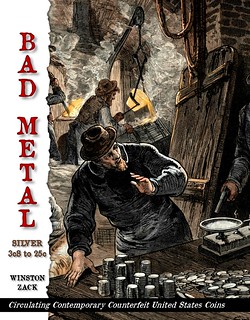 After more than 8 years of diligent
research, study, and documentation, the second book in Winston Zack's award-winning,
four-part Bad Metal book series of circulating contemporary counterfeit U.S. coins, Bad
Metal Silver. 3cS to 25c, will be printed this Fall.
After more than 8 years of diligent
research, study, and documentation, the second book in Winston Zack's award-winning,
four-part Bad Metal book series of circulating contemporary counterfeit U.S. coins, Bad
Metal Silver. 3cS to 25c, will be printed this Fall.
Bad Metal Silver. 3cS to 25c covers counterfeit silver denominations including three cent silvers (3cS), half-dimes, dimes, twenty cents, and quarters from the Bust, Seated, Barber, Renaissance, and Presidential series. This 250+ page, professionally photographed, full-color book documents more than 240 die-struck counterfeit coins along with dozens of cast counterfeits with most varieties having never been previously published. Counterfeit families of related varieties are carefully assembled with close-up pick-up-point images. And where larger families of similar looking varieties are concerned, a quick attribution guide was created in order to make identification of varieties easier and faster.
Was coin counterfeiting always viewed by the public negatively? Who would have guessed that the lowly 3cS denomination was one of the most counterfeited coins of its era! Were the so-called ‘Soviet Mercury Dimes', dated 1923-D and 1930-D, really made in the Soviet Union? Did you know that people were counterfeiting Washington quarters for circulation in the 21 st century? Discover this information and much more in Bad Metal Silver. 3cS to 25c.
This book is far and away the most comprehensive, previously untold, illustrated history covering these counterfeited coins made for circulation. While bits and pieces of this subject have been published in the past, their scattered nature had never placed them into a historical context, the motivation of counterfeiters over time was never scrutinized, nor did numismatists realize the scope and scale of this largely ignored and forgotten subject. This book defines circulating contemporary counterfeit coins as known today. The author anticipates more new discoveries and those will be posted on the badmetalcoin.com website.
Pre-order your copy of Bad Metal Silver. 3cS to 25c today for $70-shipped at https://www.badmetalcoin.com/product-page/bad-metal-silver-3cs-to-25c or at the PayPal address above. The regular book price will be $100. All pre-orders will receive an individually numbered and signed copy in the order in which they were placed.
Winston Zack is an established author of 4 numismatic books over the last 15 years. He is best-known for this Bad Metal book series covering the entirety of circulating contemporary counterfeit federal United States coinage from the late 18 th through the 21st centuries. Counterfeit half dollars and silver dollars will be the next book published in this series, and the final book will cover all counterfeit gold denominations. Anyone wishing to assist in this overall research and publication effort can contact Winston through his website or email. For more information about this subject, visit badmetalcoin.com .
For more information, or to order, see:
https://www.badmetalcoin.com/product-page/bad-metal-silver-3cs-to-25c
To read the earlier E-Sylum article, see:
NEW BOOK: BAD METAL
(https://www.coinbooks.org/v22/esylum_v22n31a07.html)
NEW BOOK: PARKS IN YOUR POCKETS
The ANA has published a new book on the national park quarters. -Editor
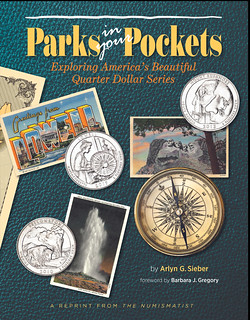 Parks in Your Pockets. Exploring America's Beautiful Quarter Dollar Series.
Parks in Your Pockets. Exploring America's Beautiful Quarter Dollar Series.
Fans of the United States Mint's 11-year program of America the Beautiful Quarters®, struck from 2010 to 2021, will be delighted by Arlyn G. Sieber's new book, Parks in Your Pockets, newly published by the American Numismatic Association. The lavishly illustrated, 120-page, softcover volume features 56 chapters based on his popular series of articles in The Numismatist and includes a foreword by former Numismatist Editor-in-Chief Barbara J. Gregory.
Although commonly referred to as national park quarters,
the series spotlights places officially designated as national monuments, forests, wildlife refuges, historic sites, lakeshores, and preserves. The coins were released in the order in which the areas came under federal protection. The familiar bust of President George Washington appears on the obverse of each. For the reverses, artists and U.S. Mint sculptor-engravers strived – and sometimes struggled—to capture the sites' essential qualities on the quarter's small canvas.
Parks in Your Pockets, with its friendly, entertaining approach, helps collectors young and old explore these imaginative and inspiring quarter dollars. Sieber's informative book truly is for everyone – numismatists, travel buffs, and anyone who appreciates the history and natural beauty of our country.
For more information, or to order, see:
Parks in Your Pockets. Exploring America's Beautiful Quarter Dollar Series.
(https://www.ebay.com/itm/314071539021)
NEW BOOK: TREASURE ROOM OF THE SAKRA KING
The ANS has published a new book on the votive coinage from Gandharan Shrines. -Editor
In the Treasure Room of the Sakra King: Votive Coinage from Gandharan Shrines
[Hardback]
Waleed Ziad(Author)
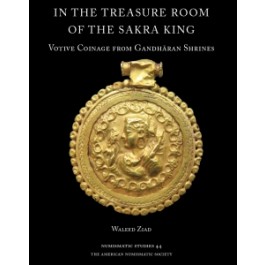 ISBN: 9780897223676
ISBN: 9780897223676
Published by: American Numismatic Society
Series: Numismatic Studies
Volume: 44
Year of Publication: 2022
240p
H11 x W8.5
In a lush valley within the Sakra peak in Gandhara (northwestern Pakistan) is a vast limestone cave temple, part of an ancient Hindu sacred complex. For over 700 years, this cluster of shrines minted hundreds of varieties of their own votive coinage – a unique case in Central and South Asia. These were miniscule copper coins, issued for pilgrims, featuring eclectic and original combinations of Greco-Roman, Iranian, Indic, and Islamic iconography. This book examines the native Sakra copper coinage issued from circa 550 to 1100, corresponding to the Nezak, Turk Shahi, Hindu Shahi, and Ghaznavid dynasties. These coins provide a window into what may have been an ecclesiastical administration exercising varying degrees of autonomy throughout its lifetime. They practically blur boundaries between vernacular folk art and monetary instruments serving political or confessional agendas.
The book relates both the remarkable story of these coins and the sacred sites, and introduces the obscured history of the most neglected yet formative 500 years of Pakistan and Afghanistan's history. It also offers new paradigms for conceptualizing local currency, the making of religious imagery, and the process of transculturation. Importantly, the Sakra coins issued under Ghaznavid rule overturn popular misconceptions about early Hindu-Muslim encounters, suggesting instead that the Ghaznavids pursued a flexible, negotiated policy with regard to Hindu sacred sites.
For more information, or to order, see:
In the Treasure Room of the Sakra King: Votive Coinage from Gandharan Shrines [Hardback]
(https://www.oxbowbooks.com/dbbc/in-the-treasure-room-of-the-sakra-king.html)
FALL NEW HAMPSHIRE BOOK SIGNING EVENT
NENA is sponsoring a numismatic book signing event this fall with several authors. John Ferreri passed along this announcement. -Editor
Sponsored by the New England Numismatic Association.
 Where??
Where??
At the the New Hampshire Coin and Currency Expo.
Convention Hall / Doubletree Hotel
700 Elm Street Manchester, New Hampshire.
When??
Friday October 14th 1-3pm At The NENA Club Tables.
Come and meet these authors: Neil Musante, Peter Jones, MD, Kevin LaFond, Manuel Ayala, John Frost, and others.
For more information on the New England Numismatic
Association and their show, see:
https://www.nenacoin.org/
To read earlier E-Sylum articles, see:
NEW BOOK: THE FIRST COINS OF THE AMERICAS
(https://www.coinbooks.org/v23/esylum_v23n47a04.html)
NEW BOOK: TREASURE!
(https://www.coinbooks.org/v25/esylum_v25n13a05.html)
NEW BOOK: CONNECTICUT TRADE TOKENS
(https://www.coinbooks.org/v22/esylum_v22n37a05.html)
NNP ADDS ORIGINAL HOBO NICKEL SOCIETY
The latest additions to the Newman Numismatic Portal are from the Original Hobo Nickel Society. Project Coordinator Len Augsburger provided the following report. -Editor
Original Hobo Nickel Society Publications on Newman Portal
 A selection of publications from the Original Hobo Nickel Society are now available on Newman Portal, including issues of their newsletter (Bo Tales) and early auction catalogs of this specialty organization. The Original Hobo Nickel Society was founded in 1992 and encourages the research, collecting, and creation of
A selection of publications from the Original Hobo Nickel Society are now available on Newman Portal, including issues of their newsletter (Bo Tales) and early auction catalogs of this specialty organization. The Original Hobo Nickel Society was founded in 1992 and encourages the research, collecting, and creation of hobo nickels,
which are post-Mint carved Buffalo nickels. Newman Portal acknowledges Ralph Winter, Bo Tales editor, for his assistance with this title.
Image: Elvis Presley, carved on the obverse of a Buffalo nickel, created by Aleksey Saburov
The first ten years are complete (1992-2002), and a few more recent issues are also available as examples. -Editor
Link to Original Hobo Nickel Society home page:
http://www.hobonickels.org/
Link to Bo Tales on Newman Portal (1992-2021)
https://nnp.wustl.edu/library/publisherdetail/546873
Link to Original Hobo Nickel Society auction sale catalogs on NNP:
https://nnp.wustl.edu/library/auctioncompanydetail/514437
VIDEO: MAY 2022 PAN COIN SHOW BANQUET
These are selections from the David Lisot Video Library that feature news and personalities from the world of coin collecting. David has been attending coin conventions since 1972 and began videotaping in 1985. The Newman Numismatic Portal now lists all David's videos on their website at:
https://nnp.wustl.edu/library/multimediadetail/522852
Here's one on the May 2022 PAN Coin Show Banquet. -Editor
Tom Uram Hosts PAN Coin Show Banquet 2022.
VIDEO: 51:12
Tom Uram, President, Pennsylvania Association of Numismatists
David Lisot, Video Producer, Coin Television.com.
The PAN Coin Show Banquet was a regal affair hosted by PAN President, Tom Uram. This banquet includes appearances by Dennis Boggs as Abraham Lincoln, Don Carlucci, Patrick McBride as Ben Franklin, Brett Irick, Bob Hurst, Rick Lank, and more.
David adds:
"Tom Uram is the ANA's 2022 Chester L. Krause Memorial Award Recipient and president of PAN, the Pennsylvania Association of Numismatists. For those people in the hobby who have not had the pleasure of meeting Tom this video shows Tom's humor and enormous enthusiasm for numismatics. Tom is committed coin collecting and deserving of all his accolades!"
An excerpt of the video is available for viewing on the Coin Television YouTube Channel at:
https://youtu.be/B-gZM-Cp89o
DELUXE EDITIONS OF MOULTON BOOK ON VOIGT
David Fanning of Kolbe & Fanning Numismatic Booksellers writes:
"The timing of the recent questions about the planned deluxe edition of Karl Moulton's book on Henry Voigt is fortuitous. By coincidence, we had just been shipped a number of boxes of these undistributed volumes, and we will be ready to offer them in the near future.
"While I do not know the background on these in its entirety, I can say that the books exist in quarto format, and are a large-paper edition (that is, the text block is the same as in the octavo trade edition) bound in white or brown processed leather. They are gilt-stamped on the front cover and spine and come in a variety of colors of marbled endpapers. The Cardinal Collection Educational Foundation underwrote the production of these special editions, but the books remained undistributed for reasons unknown to me. Further information will be available soon. In the meantime, two copies of the book are included in our Sale 165 as lots 321 and 322:"
Thanks, that's great news. -Editor
Moulton, Karl. HENRY VOIGT AND OTHERS INVOLVED WITH AMERICA'S EARLY COINAGE. Sunnyvale, 2007. 4to, original white leather, front cover bordered and lettered in gilt with enlarged color photograph of the 1792 half disme mounted; spine with four raised bands, ruled, lettered and decorated in gilt; marbled endpapers. (4), vii, (1), 231, (1) pages; illustrated, often in color. Fine. The rarely seen large-paper edition (the regular edition is an octavo), which was bound in two different leathers. Ex Cardinal Collection Library.
Moulton, Karl. HENRY VOIGT AND OTHERS INVOLVED WITH AMERICA'S EARLY COINAGE. Sunnyvale, 2007. 4to, original brown leather, front cover bordered and lettered in gilt with enlarged color photograph of the 1792 half disme mounted; spine with four raised bands, ruled, lettered and decorated in gilt; marbled endpapers. (4), vii, (1), 231, (1) pages; illustrated, often in color. Fine. The rarely seen large-paper edition (the regular edition is an octavo), which was bound in two different leathers. Ex Cardinal Collection Library.
For more information, or to bid, see:
Deluxe Moulton on Voigt, in White
(https://bid.numislit.com/lots/view/1-69DHEN/deluxe-moulton-on-voigt-in-white)
Deluxe Moulton on Voigt, in Brown
(https://bid.numislit.com/lots/view/1-69DHEP/deluxe-moulton-on-voigt-in-brown)
To read the earlier E-Sylum article, see:
KARL MOULTON'S HENRY VOIGT BOOK
(https://www.coinbooks.org/v25/esylum_v25n29a05.html)
1785 CONTINENTAL DOLLAR SALE IN NUREMBERG
Julia Casey submitted these additional research notes on the 1785 Continental Dollar Sale in Nuremberg. Thank you! More pieces to the puzzle of the origin of the Continental Dollar coins/medals. -Editor
Michael von Seufferheld and the 1785 Continental Dollar Sale in Nuremberg
 The 1785 catalog for the von Seufferheld collection is the earliest documented sale of a
The 1785 catalog for the von Seufferheld collection is the earliest documented sale of a Continental dollar.
This sale has been used by proponents on both sides of the debate to support their theories about the origin and intent for the minting of the Continental dollar
pieces. The traditional concept that the Continental dollar
was issued as an American dollar is supported by the catalog description of the piece as munze
i.e., a coin. As well, a Continental dollar
first being offered for sale in Germany supports the more recent perception that these pieces were struck in Europe.
The owner of this collection is identified as Michael von Seufferheld by Joachim Rex in Beiträge zum Buch- und Bibliothekswesen (Contributions to Books and Libraries), Volume 44 (2002). Johann Michael von Seufferheld (1728-1784) was a banker and commercial court assessor in Nuremberg and received an Adelsbrief
or nobility status in Vienna in 1771. While his full given name includes Johann,
von Seufferheld was commonly listed in literature and records as Michael von Seufferheld.
Von Seufferheld was also a well-known coin collector. In the 1782 publication of Neue Beyträge zur Geschichte und Münzwissenschaft (New Contributions to History and Numismatics) the numismatist Johann Jakob Spiess (Spieß) called him a grosser Thalersammler und Kenner
(great Thaler-collector and connoisseur). Von Seufferheld was said to have been friendly with the Swiss (Bernese) historian/numismatist Gottlieb Emmanuel von Haller (1735-1786). Von Haller's biographer, Hans Haeberli, wrote that von Seufferheld would track German auctions for pieces that might be of interest to von Haller.
Gottlieb Emmanuel von Haller was the son of the great Swiss anatomist Albrecht von Haller, and his younger half-brother was the Parisian banker Rudolf Emmanuel von Haller (1747-1833). This trail of breadcrumbs from von Seufferheld to the von Haller family next leads us to Paris and Benjamin Franklin.
Rudolf Emmanuel von Haller corresponded with Franklin and is described on the Founders Online website as being unsuccessful in a bid for his firm to be the primary bankers to the American commission. It is also stated that he was known as a brilliant though not always scrupulous businessman, Haller used his contacts in Holland, England and Paris to speculate broadly on the war.
Might the Continental dollar
pieces have been struck in an attempt by Rudolf Emmanuel von Haller to impress Franklin and persuade him to engage with Girardot, Haller & Cie.?
It would appear, based on von Seufferheld's 1784 date of death, that this 1785 sale was for estate purposes. This information serves to date von Seufferheld's acquisition of the Continental dollar
to 1784 or earlier. While we can see that Von Seufferheld, and/or the cataloger of his collection, placed the Continental dollar
within the categorization of a coin. Since von Seufferheld was not alive at the time of the sale we cannot be certain if this designation was made by him or the individual handling the sale of his estate.
However, this does not necessarily confirm that the Continental dollar
was struck with the intent to pass as an American coin. If Continental dollar
pieces were struck in Europe and first offered to collectors there, some of whom would have believed it to be an American coin. Subsequently, if Continental dollars
were offered for sale in England to collectors such as Sarah Sophia Banks, they could have believed it to be a medal. In both cases, Continental dollar
pieces were offered to be sold, not to circulate. After all, Sarah Sophia Banks's ledger recorded that they were "never current, struck on speculation in Europe, for sale in America." The intent may have always been that the "Continental dollars" were made to be sold, whether they were sold as "coins" or as "medals" was inconsequential, so long as they were sold.
LINKS:
Neue Beyträge zur Geschichte und Münzwissenschaft, Volume 1
By Johann Jakob Spieß
https://books.google.com/books?id=dJ5MAAAAcAAJ&pg=PA46&dq=%
22grosser+Thalersammler+und+Kenner%22&hl=en&newbks=1&newbks_redir=0
&sa=X&ved=2ahUKEwir5NiIraz5AhVdEFkFHSa2DdAQ6AF6BAgDEAI#v
=onepage&q=%22grosser%20Thalersammler%20und%20Kenner%22&f=false
To Benjamin Franklin from Rodolphe-Emmanuel Haller, 5 September 1778
https://founders.archives.gov/documents/Franklin/01-27-02-0335
To read earlier E-Sylum articles, see:
CONTINENTAL DOLLAR OFFERED FOR SALE IN 1785
(https://www.coinbooks.org/v24/esylum_v24n12a10.html)
MORE ON THE 1785 CONTINENTAL DOLLAR SALE
(https://www.coinbooks.org/v24/esylum_v24n13a08.html)
NEWSLETTER EDITORS GROUP TO MEET AT ANA
This announcement appeared in the August 2022 issue of the E-Gobrecht from the Liberty Seated Collectors Club. Great project! -Editor
Fellow Newsletter Editors for all Local Coin Clubs:
My experience with coin clubs from around the country has reinforced the view that club newsletters provide a cohesive element for club functioning.
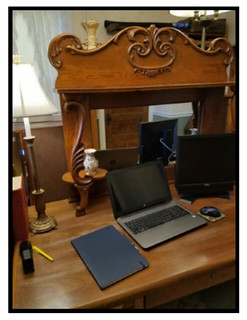 The purpose of our informal Newsletter Editors Group is to help local
clubs by sharing ideas, providing assistance and facilitating crosstalk to
improve our newsletters.
The purpose of our informal Newsletter Editors Group is to help local
clubs by sharing ideas, providing assistance and facilitating crosstalk to
improve our newsletters.
We will have our first in-person workshop at the Worlds Fair of Money on Friday, August 19th, from 10 AM to noon in room 22. If you are coming to the Worlds Fair of Money, I hope you will join us. Other club participants are also welcome.
I hope to have a Zoom get together in October with another in-person workshop at the National Money Show in March.
The basic premise is that the best newsletter for a club is the one that
serves the club best – there is no one formula for everyone. You may also be
interested in my eLearning presentation from a few years back: Creating a
Great Club Newsletter.
(https://youtu.be/rVITX2s48PY)
I look forward to meeting you all soon!
Phil Vitale
Albuquerque Coin Club
moneyman75X@outlook.com
COLLECTOR EXHIBITS AT THE 2022 CHICAGO ANA
The upcoming American Numismatic Association World's Fair of Money® will feature a full range of exhibits. Paul Hybert of the Chicago Coin Club submitted this report. Thanks - the exhibit area is one of my favorite parts of every convention. -Editor
An online guide to the Collector Exhibit Area at the 2022 World's Fair of Money is available online at: http://www.chicagocoinclub.org/events/2022/ana/ex/all_by_cl.html .
The Collector Exhibits are no longer listed in the Show Guide. The above guide groups the exhibits by Exhibit Class, while the ANA website has one listing of all exhibits at https://www.money.org/wfm/exhibit-descriptions .
Visit this page before you arrive at the convention center to determine your must-see exhibits, or visit this page to help you remember that exhibit you want to see again! This page will be updated during the convention, to list just the exhibits which are present. The Collector Exhibit Area will be near the club tables -- stop by!
There's only one Numismatic Literature exhibit this year, but it promises "To display rare and interesting numismatic literature from a lifetime of collecting, including close to 10 unique or likely unique items."
Look for other exhibits of colonial paper money, 1896 Educational Notes, Assay Commission Medals, ancient coinage, German States Wildman Thalers, Philippines medals, numismatic art from Andy Warhol and Peter Max, and "the only U.S. notes that depict an elephant." -Editor
NOTES FROM E-SYLUM READERS: AUGUST 7, 2022
More on Collecting U.S. Treasury Checks
Norm Cochrane writes:
"Because of the article in the July 31st issue of The E-Sylum, I am confessing to not cashing a Treasurer of the U.S. check. The check No. 99,923,506 for $1.00 is dated 10/19/73 and directly below the date is CCDOLLAR
. The $1.00 is the excess over the minimum bid price for an 1884 CC silver dollar which I still have. Therefore I have a silver and a paper
Carson City dollar."
Thank you! This is great numismatic ephemera. -Editor
To read the earlier E-Sylum article, see:
NOTES FROM E-SYLUM READERS: JULY 31, 2022 : Uncle Sam's Free Numismatic Collectibles
(https://www.coinbooks.org/v25/esylum_v25n31a09.html)
More on the 1963 "Famous Old Collection"
Regarding the 1963 "Famous Old Collection" that Dave Hirt asked about,
Julia Casey writes:
"I just did some lucky Google searching and located some information about this sale. There is an interesting 2008 post about it by a Collectors Universe forum member named "firstmint"."
In early 1963 when Breen wasn't working as a cataloguer (he was in between jobs from New Netherlands & Lester Merkin) he was asked to validate some early US proofs from a "Famous Old Collection". This was none other than the Joseph Reakirt collection of American coins which had been put together in the 1860's.
For those who don't know, Reakirt is the person who bought the 1827 three piece "proof set" from the October 1867 Joseph Mickley sale. Reakirt was a buyer of many nice coins which were labeled as "proof" at the time.
After reviewing the material, Breen told the cataloguers (Columbus Stamp and Coin) "there were no true proofs before 1855 other than dollars, but are choice first strikes from polished dies and some of the coins listed are the finest known". This was the only time where Breen had the situation correct in print regarding early US coinage with reflective surfaces.
This little known auction was published in the March 1963 Numismatic Scrapbook, as well as being typed up for lot viewers beforehand. Abe Kosoff ended up purchasing this entire group. The Reakirt sale ranks in importance right along side the Garrett sales, but unfortunately, was not presented properly.
Thanks - nice find! The Newman Portal has at least eight references to Joseph Reakirt, so this may be a ripe topic for someone to further research. -Editor
To read the complete discussion thread, see:
How Reliable is Walter Breen's info?
(https://forums.collectors.com/discussion/comment/6914897)
To read the earlier E-Sylum article, see:
NOTES FROM E-SYLUM READERS: JULY 31, 2022 : Query: 1963 Famous Old Collection Sale
(https://www.coinbooks.org/v25/esylum_v25n31a09.html)
Thanks to Ted Puls
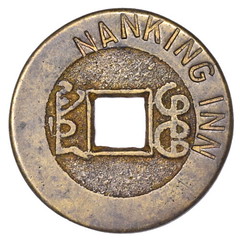 Bob Merchant writes:
Bob Merchant writes:
"Thanks for highlighting the counterstamped Chinese coin. Below is my reply to Ted Puls who researched and submitted the attribution for the coin:
"Thanks Ted! I have forwarded your research information to the buyer of the counterstamped coin."
To read the earlier E-Sylum article, see:
NOTES FROM E-SYLUM READERS: JULY 31, 2022 : Counterstamped Chinese Cash Coin Identified
(https://www.coinbooks.org/v25/esylum_v25n31a09.html)
Growing Up With Reinfeld's Numismatic Books
Martin Purdy writes:
 "As a kid in small-town New Zealand I devoured every coin book our local public library had - in the days when libraries (a) had and (b) retained decent book stocks for a reasonable length of time. A favourite, borrowed many times over, was Catalog of the World's Most Popular Coins by Reinfeld and Hobson. Several decades later I acquired, for my own library, examples of numerous titles that I'd read in those early years, including Reinfeld's Catalog. Even now I just have to open it to be transported back almost 50 years to a time when almost everything in it was a new discovery for me."
"As a kid in small-town New Zealand I devoured every coin book our local public library had - in the days when libraries (a) had and (b) retained decent book stocks for a reasonable length of time. A favourite, borrowed many times over, was Catalog of the World's Most Popular Coins by Reinfeld and Hobson. Several decades later I acquired, for my own library, examples of numerous titles that I'd read in those early years, including Reinfeld's Catalog. Even now I just have to open it to be transported back almost 50 years to a time when almost everything in it was a new discovery for me."
Smarty Pants Answer: Six Days of the Condor
Pete Smith writes:
"Last week I asked the question, What novel uses Reinfeld quotes to introduce several chapters?
There was no answer from readers.
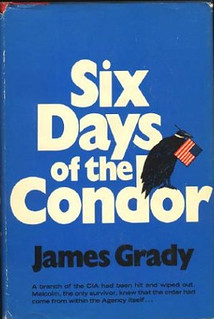 "Ronald Malcom was a CIA agent who analyzed plots of mystery and spy novels. He was out to
lunch one day when gunmen invaded the office and killed everyone there. He went into hiding,
not knowing who he could trust.
"Ronald Malcom was a CIA agent who analyzed plots of mystery and spy novels. He was out to
lunch one day when gunmen invaded the office and killed everyone there. He went into hiding,
not knowing who he could trust.
"This is the premise for Six Days of the Condor, a 1974 novel by James Grady. Believing that six days was too intense, it was made into a 1975 movie as Three Days of the Condor, directed by Sydney Pollack.
"I wanted to see a copy to confirm the Reinfeld quotes. My local branch library told me the nearest copy was more than sixty miles away. That means there was no available copy within the Minneapolis / St. Paul metropolitan area. I did not make the trip.
"Now that you know the title, who can come up with the quotes?"
I borrowed an online copy of the book for an hour through the Internet Archive's controlled lending program. While every chapter does begin with a quote, only five are from Fred Reinfeld. He's in good company - others quoted include Napoleon and Presidents Lyndon Johnson and Dwight Eisenhower. -Editor
Thursday Afternoon (p41)
"Faulty execution of a winning combination has lost many a game on the very brink of victory. In such cases a player sees the winning idea, plays the winning sacrifice and then inverts the order of his follow-up moves or misses the clinching point of his combination."
-Fred Reinfeld, The Complete Chess Course
Thursday Evening - Friday Morning (p57)
"I have treated this game in great detail because I think it is important for the student to see what he's up against, and how he ought to go about solving the problems of practical play. You may not be able to play the defense and counterattack this well, but the game sets a worthwhile goal for you to achieve: how to fight back in a position where our opponent has greater mobility and better prospects."
-Fred Reinfeld, The Complete Chess Course
There are other Reinfeld quotes about Overconfidence on p80 (Saturday), Defensive Play on p132 (Late Monday), and Crisis on p143 (Tuesday, Morning through Early Evening).
To borrow the eBook, see:
https://archive.org/details/sixdaysofcondor00grad/page/20/mode/2up
To read the earlier E-Sylum article, see:
FRED REINFELD (1910-1964)
(https://www.coinbooks.org/v25/esylum_v25n31a13.html)
1793 U.S. Coin Errors
Jim Neiswinter writes:
"The quality control at the mint in 1793 was a lot better than in following years. Errors in that first year are very rare. The S11a that is being sold by Sullivan was the second off center in my sale. The first was an S10 that was also 10% off center, but was a problem free coin. There was also an S6 in XF 45 that was double struck with a plain edge.
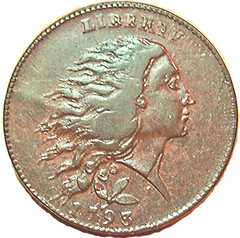 "The best error by far of 1793 is an obverse brockage of an S8 or S9. This coin was my
"The best error by far of 1793 is an obverse brockage of an S8 or S9. This coin was my white whale
that I had wanted for years, but the owner, a guy who went to my high school, would never consider selling."
Thank you. Great coins. -Editor
To read the earlier E-Sylum article, see:
NUMISMATIC NUGGETS: JULY 31, 2022 : 1793 Off-Center Wreath Cent
(https://www.coinbooks.org/v25/esylum_v25n31a20.html)
Missing: Denver Mint Coinage Dies Volume
"A volume of coinage dies for the Denver Mint from 1926 to at least 1938 has been missing for several decades. It is possible the rectangular book is sitting in a second hand book shop, or has found its way to a book collection. Readers are asked to be on the lookout for a maroon and black volume with gold lettering similar to the above photo, but without the blue damage at lower left. It will have the identical form number 864 and title as the illustration.
"If found, it can be repatriated confidentially."
Be on the lookout, bibliophiles! -Editor
Indian Peace Medal Recipient List Sought
Paul Horner writes:
"Can a reader please direct me to a resource that lists the names, tribes & dates of the recipients of Indian Peace Medals? Thanks! "
I'm not sure if there is any ONE source for this information. What are readers aware of? Thanks. -Editor
JOSEPH WRIGHT OF BORDENTOWN, NEW JERSEY
Mike Costanzo submitted this note about U.S. Mint engraver Joseph Wright and other luminaries of Bordentown, New Jersey. Thanks! -Editor
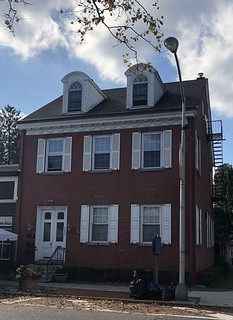 Joseph Wright was considered the first chief engraver of the U.S. Mint by many, although he died before he was officially confirmed. Wright was born in Bordentown, New Jersey, which was located next to the small town of Groveville, where I grew up and started collecting as a youngster. A recent search for any Wright-associated landmarks in Bordentown turned up Wright's childhood home, which still stands. Surprisingly, Wright was not given top billing. This went to his mother, Patience, who was an accomplished sculptor as well as a "female spy". On a metal sign outside of the house, Joseph is noted only as a "noted painter." A small bronze plaque attached to the home, however, duly notes Wright as the "Designer of Original U.S. Coins."
Joseph Wright was considered the first chief engraver of the U.S. Mint by many, although he died before he was officially confirmed. Wright was born in Bordentown, New Jersey, which was located next to the small town of Groveville, where I grew up and started collecting as a youngster. A recent search for any Wright-associated landmarks in Bordentown turned up Wright's childhood home, which still stands. Surprisingly, Wright was not given top billing. This went to his mother, Patience, who was an accomplished sculptor as well as a "female spy". On a metal sign outside of the house, Joseph is noted only as a "noted painter." A small bronze plaque attached to the home, however, duly notes Wright as the "Designer of Original U.S. Coins."
 Bordentown was a small but popular town during the American Revolution, located between Philadelphia and New York City and featured other notable residents with numismatic connections as well. This includes author Thomas Paine, who later became the subject of satirical medals for his involvement in the French revolution. Exiled King Joseph Bonaparte also resided in Bordentown. Bonaparte was the brother of Napoleon, and as king of Spain and Naples, was depicted on Spanish coinage.
Bordentown was a small but popular town during the American Revolution, located between Philadelphia and New York City and featured other notable residents with numismatic connections as well. This includes author Thomas Paine, who later became the subject of satirical medals for his involvement in the French revolution. Exiled King Joseph Bonaparte also resided in Bordentown. Bonaparte was the brother of Napoleon, and as king of Spain and Naples, was depicted on Spanish coinage.
Mike adds:
"I grew up about three miles from the house but never knew it at the time."
MCNALLY FAIRBANKS COIN SCALES
Malcolm Mathias of Forest Hill, Victoria, Australia writes:
"I am researching all the different versions of the McNally Fairbanks counterfeit coin detectors with the intention of eventually publishing a detailed article describing and cataloguing all the different versions for the collectors out there – both numismatists and scale collectors, and those that do both. I have reached a point where I need to reach out for other examples and other information from other collectors."
This is a great companion topic for the just-announced book by Winston Zack on counterfeits of U.S. coins. Scales like these were how merchants of the day identified the fakes that came into their shops. -Editor
McNally – Fairbanks – U.S.Coin – M.B.Coin - Abbott Machine Co CCDs
In 1862 the New York Times reported that 80% of American currency in circulation was counterfeit. In 1865 the US Federal Government created the Secret Service and over the next 40 years counterfeiting was eradicated as a major crime. Clever inventors made various counterfeit coin detectors to assist banks, shop-keepers, and the public to identify the genuine from the counterfeit.
An advertisement in The American Banker of May 1879 announced the availability of a New Invention
- the J.T.McNally Gold and Silver Counterfeit Coin Detector.
J.T.McNally. Inventor
inscribed on the rocker
beam - mounted on a wooden base.
Note the small hole in the base at lower right -
the small gold dollar counterweight pin is often
missing from these scales.
Unfortunately, there were complications with the
US Patent application which allowed others to
mimic the balancing
structure of the original
J.T.McNally invention, and through minor
changes of the design, competitors were able to
market different versions of the Mc Nally
invention under their own name.
Picture: Fairbanks & Co
There are at least eight different known
versions of the basic McNally rocker CCD:
1. James T. McNally on a wooden base and labelled J.T.McNally. Inventor
on the beam.
2. Fairbanks & Co on an elongated black metal base and labelled Fairbanks & Co
on the beam
3. Fairbanks Infallible on an elongated black metal base and labelled The Fairbanks Infallible
Scale Co Baltimore, MD. U.S.A.
on the beam.
4. U.S. Coin Co on a rectangular black metal base and labelled U.S. Coin Scale 31 Broad St
N.Y.
on the beam.
5. M.B.Coin Co on an elongated black metal base and labelled M.B.Co.
on the beam.
6. Abbott Machine Co, Chicago on a wooden base and labelled Abbott Machine Co Chicago
on the beam.
7. Abbott Machine Co, Chicago on a black metal base and labelled Abbott Machine Co
Chicago
on the beam.
8. Fairbanks & Co on a wooden base and labelled Fairbanks & Co
on the beam.
9. The small counterweight pin (as shown in transparent bag in Fairbanks & Co picture above) for helping to counterbalance the small $1 gold coin is invariably missing.
I am researching all versions of the McNally CCD to create a detailed illustrated listing of all versions as a reference source for collectors. I now own 1, 2, 3, 4, and 5 above, but I am chasing 6, 7, 8 and 9 in the above list.
Version 6 Wanted: Abbot Machine Co. Chicago The rocker has nine slots to measure the weight, diameter, and thickness of all U.S. gold and silver coin denominations from 25 cents to 20 dollars.
The slotted beam was mounted on either a walnut or mahogany base. Abbott Machine Co. Chicago is inscribed on the beam.
Version 7 Wanted: New design
for the Abbott Machine Co. Chicago
advertised in the American Stationer Dec 4, 1890
The distinctive shape of the new design
metal base is painted black and decorated with
fine gold flecks painted over the black base.
Note the counterweight pin in the lower left of
the black base.
Wanted: Australian collector happy to pay a reasonable price for either Abbott Machine Co version (6 or 7) and/or the Fairbanks version (8) on a wooden base and/or an original counterweight pin (9).
Are there any other
versions known? Photographs of other
versions would be much appreciated.
Please contact Malcolm Mathias, Australian member of the International Society of Antique Scale Collectors (ISASC) via email mathias.m.h@bigpond.com .
Can anyone help? Great research topic. -Editor
ANTIQUARIAN BOOKS IN NUMISMATIC STUDIES
Bob Van Arsdell published a new article with a warning about using antiquarian books for numismatic studies. -Editor
Bob writes:
"It took 250 years to identify the coins of an Ancient British king because an erroneous image from 1610 was copied over and over. The king's coinage could have been identified immediately, but repeated scholarly errors made it invisible
to the public. It's gives us a warning that working from images, rather than the coins themselves, carries risks for numismatic researchers."
Great advice. Here's an excerpt - see the complete article online. -Editor
The Invisible Coinage of Verica
In the late 1500s, antiquarian writers began to study Ancient British coins. Some coin inscriptions seemed to match the accounts of ancient Roman authors. Camden and Speed used these coins to illuminate a murky period in British history.
Cunobeline's coins were identified first. His large coinage with a bold "CVNO" was hard to miss – Camden illustrated four Cunobeline types in the 1590 edition of his Britannia. These are the earliest images of Ancient British coins to appear in print.
Surprisingly, the large coinage of Verica was not identified for another 250 years. Although a Verica stater was found before 1610, it was misattributed as a coin of Commius. Scholarly errors over the next two centuries made the coinage of Verica "invisible" to the general public.
The stater was mis-attibuted because it had been struck from damaged dies – the inscriptions could easily be misread. And, of course, Commius was a prominent figure in Caesar's Gallic War. The attribution to such a famous man proved to be an exciting discovery. It was easy to miss the correct attribution to Verica. He's only mentioned by Dio in one sentence.
The Early Reports
Camden's 1590 third edition of the Britannia showed five ancient British coins: four of Cunobeline and one uncertain type. He'd used them merely as illustrations, with little description. But the illustrations proved to be popular and attuned readers to the idea that the Ancient Britons used proper coins.
Camden's success started off a three hundred year search for coins struck by rulers mentioned in Caesar, Dio Cassius and other ancient authors.
Camden 1607-1610
 Within twenty years, a gold stater of Verica was discovered. Camden used it as an illustration in the 1610 edition of the Britannia.
Within twenty years, a gold stater of Verica was discovered. Camden used it as an illustration in the 1610 edition of the Britannia.
Unfortunately, Camden misread the inscription on the obverse, and attributed the coin to Commius, not Verica. Commius was a major figure in Caesar's Gallic War. Verica was mentioned only in one obscure passage in Dio. Of the two, Commius was probably the better choice at the time.
Today, examples of the type are known from a set of dies that became very worn. As luck would have it, Camden's coin would be struck from the worst state of the pair. The "VER" above the horse is very weak, and the FI in "COM-FI" is almost obliterated. Camden would ignore the VER and FI completely and take the inscriptions to read COM REX – Commius, King. Numismatic authors would repeat this error for the next 200 years. Ackerman would eventually illustrate the coin correctly (in 1846) and Evans would begin to publish the facts in 1864.
To read the complete article, see:
The Invisible Coinage of Verica
(https://vanarsdellcelticcoinageofbritain.com/articles-numismatic_ccb3/van_arsdell_2022b_ccb3.html)
VOCABULARY TERM: LETTERING
Here's another entry from Dick Johnson's Encyclopedia of Coin and Medal Terminology. I added the medal image. -Editor
Lettering. The wording on coins and medals, often highly abbreviated. There are two kinds of lettering, those that follow the perimeter of the item – the legend – usually in an arc base line (called bowed), and all other lettering, the inscription. Lettering did not appear on the first coins of Lydia (in 640 bc), but appeared shortly thereafter, about 580 bc. It has been a necessary element of coin and medal design ever since.
Coin and medal lettering is included in the study of epigraphy, and is of considerable importance because of the minimal amount of errors on numismatic and medallic items. Scholars and historians often refer to coins and medals for historical fact or corroboration of an event or date from the vast documentation that these contemporary items provide – the lettering appearing on coins and medals are presumed accurate with extremely high veracity.
Language and letter forms. Lettering has appeared in many type styles in numismatic and medallic art, usually indigenous to the language on the piece. For example, fraktur type style appears on Germanic objects, the distinctive letter or word forms of Arabic and Oriental languages on the coins and medals of those areas.
The customary letter form for numismatic wording is capital letters – upper case – a custom inherited directly from the inscriptions on Greek and Roman buildings. From time to time coin and medal designers have, however, experimented with lower case letters. American medallist Paul Manship once used caps and small caps on the obverse of the North Carolina Award Medal (63-34) and caps and lower case on the reverse.
The type style on coins and medals is considered somewhat "heavy," what a printer would call bold face. Thin letters are not appropriate for numismatic design nor for striking. Letters on coins and medals appear with both serifs, the little tails or cross strokes on the ends of letter forms, and sans-serif, without these.
Lettering by punches versus hand cutting. When most dies were prepared by hand – prior to 1900 – much of the lettering was done with punches, one letter at a time. Engravers maintained sets of letter punches – in sizes and styles suitable for their diesinking work. A punched letter saved the engraver time in hand cutting each letter; it also added uniformity and clarity to the inscription or legend. However, if he so chose he would hand cut the letters. Thus a wide variety of letter styles exists in numismatic and medallic art (but not anywhere near the many type styles found in printing).
Generally letters formed by punches are flatter on top and have more steeply sloping sides with sharp angles at the bottom where the letter joins the background. There may be some doubling of letters as punches shift between blows. Hand carved letters on the other hand, lack uniformity and, depending upon the experience of the engraver, vary minutely in size and shape among the lettering. The best diagnostic evidence in determining that a die was made with punches (and probably hand engraved) is this uniformity of letter shapes.
Modeled lettering. Some artists making oversize models to be pantographically reduced utilize FORM LETTERS. This is done to reduce the time of carving each letter. Other artists – in an attempt to retain more control over the appearance of the lettering and to make it as harmonious as possible with the design – will cast their own letters and attach each one to the model. Still others will carve the letters right in the model (more often the choice of the most experienced medallist).
Modeled lettering appears more soft in appearance, generally with rounded tops, more sloping sides and the letters do not have the sharp angles that punches provide. With the increasing use of the oversized model, reduced by pantograph, lettering took on more flexibility and, more often, a pleasing appearance.
Base lines. In all instances, the use of punches or form letters – or even hand engraving or carving letters by hand – an important function of the artist is to maintain an even base line. Tilted letters, or those off the base line, is the mark of an amateur or inexperienced engraver, seasoned diesinkers and medalists would never allow this on finished work.
Not all base lines are straight. Placing letters on the bowed base line for the legend is quite critical and very common. The undulating base line, in wave form, is also difficult, but very uncommon.
History of lettering. Lettering on ancient coins, including the first in 580 bc, was engraved by hand into the die along with the devices. Thus lettering was kept to a minimum. With the use of punches in the middle ages, all lettering was created with letter punches (and even some devices were formed with letter punches). It was not until the perfection of the die-engraving pantograph that an oversize model could be reduced all at once, with both devices and lettering that lettering was formed by the modeler. This occurred at the turn of the 20th century.
Lettering problems. In addition to maintaining an even base line, forming the lettering on a design or a die – whether by punches or by modelling – the arrangement is of concern to the engraver or medallist. The size and arrangement of letters, the letterspacing, and the interspacial relationship among all elements of the design including lettering, are important.
Lettering must be kept to a minimum because of space limits on every coin or medal. Thus the designer must be aware of these spatial limitations; words, titles and mottoes are always kept short or forced to be abbreviated.
Cataloging lettering. The side of a coin or medal whose design is entirely lettering is called typographic and this should be noted in any cataloging. Several examples are illustrated here. This is the opposite of no lettering whatsoever, called anepigraphic. Lettering with Roman numerals in large size than the rest of the lettering – spelling out the date – is a chronogram, and of vital importance in dating the piece; it should always be noted in cataloging.
Lettering that is added after the medal was issued, as a name and date of an award, is called inscribed. Lettering removed from a medallic item is called obliterated. An example might be a recipient who removes his name (literally grinding it off) before he disposes of the piece, such an area is called obliterated name. It too, should be noted in cataloging. If a new name is added, it is called renamed.
The type style is not usually recorded in cataloging numismatic items. The exact wording, however, is recorded precisely, including punctuation, along with dots, center dots and ornaments. Arms or stems of letters may be described as pointed or blunt.
To read the complete entry on the Newman Numismatic Portal, see:
Lettering
(https://nnp.wustl.edu/library/dictionarydetail/516231)
THE BOOK BAZARRE
BURTON HAROLD HOBSON
American Numismatic Biographies author Pete Smith submitted this article on author Burton Hobson. Thanks! -Editor
 When Fred Reinfeld died at age 54 in 1964, Burt Hobson took over as the writer of books for
numismatic novices.
When Fred Reinfeld died at age 54 in 1964, Burt Hobson took over as the writer of books for
numismatic novices.
Burt Hobson was born in Galesburg, Illinois, on April 16, 1933, the son of Burt (1909-1985) and Geneva Sornberger Hobson (1908-2003). His father was an electrical supplies salesman.
Hobson married Maxine C. Meyer on August 9, 1953. They had a daughter and two sons.
Hobson was an outstanding student in high school and won a partial scholarship to the University of Chicago at age 17. After completing his junior year at Rock Island High School in 1950, he was admitted as an early entry to the University of Chicago. He received a B. A. from the University of Chicago in 1953.
His first job was manager of the coin department at Marshall Field & Company in Chicago. In 1961 he became sales manager for President Coin Company, a subsidiary of Sterling Publishing Company, Inc. in New York City. Sterling was noted for publishing the Guinness Book of World Records. He advanced to vice president of sales for 1966-1972, executive vice president 1972-1979. Hobson became president of Sterling in 1979 and chairman of the board after 1995, now retired.
Burton H. Hobson joined the ANA in 1955 as member 24738. He was honored as a 40-year member in 1995 but not as a 50-year member in 2005. He was also a member of the American Numismatic Society.
Hobson got started in numismatic writing with Getting Started in Coin Collecting published in 1961. He is listed as co-author of several titles with Fred Reinfeld. Most of Hobson's contributions were completing unpublished works of Reinfeld and later revisions following the death of Reinfeld. He received a Robert Friedberg Award from the PNG in 1972 for Historic Gold Coins of the World.
Hobson had extensive interests outside numismatics which he supported with financial contributions. Burton served as national president of Confrerie de la Chaine des Rotisseurs. Burton and Maxine were trustees of the Culinary Institute of America. Burton was a trustee of the Wildlife Trust. He was an honorary trustee of the American Academy of Chefs.
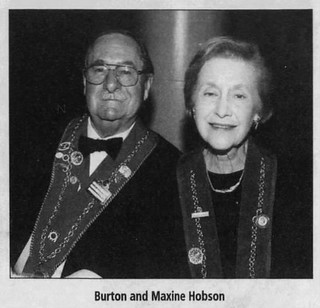 I could not find a photo of Burton while he was writing his numismatic books. I did find a photo
of Burton and Maxine at a 2002 event in Palm Beach. [Palm Beach Daily News January 24,
2002]
I could not find a photo of Burton while he was writing his numismatic books. I did find a photo
of Burton and Maxine at a 2002 event in Palm Beach. [Palm Beach Daily News January 24,
2002]
In 2002, Hobson was awarded an honorary Doctor of Humane Letters degree from Johnson & Western University. Also in 2002, his book Gastronome was published including reprints from the magazine. Hobson was credited with converting the magazine to a full color format. Compounding the honors, he was inducted as an honorary member of the American Academy of Chefs Culinary Hall of Fame.
Maxine Hobson died on February 18, 2019, leaving her husband Burton as a survivor. At last report, he is still living.
Books by Burton Hobson
- Getting Started in Coin Collecting (1961, 1967, 1969)
- Coin Collecting as a Hobby (1964, 1967, 1969, 1972, 1976, 1977, 1980, 1982, 1986)
- Coins and Coin Collecting (1965, 1971)
- Hidden Values in Coins (1965, 1966)
- What You Should Know About Coins & Coin Collecting (1965)
- International Guide to Coin Collecting (1966)
- Coin Identifier (1966)
- Coins You Can Collect (1967, 1970)
- Catalogue of Scandinavian Coins (1970, 1972)
- Historic Gold Coins of the World (1971)
- Catalogue of North, South and Central American Coins (1980)
Books by Burton Hobson and Fred Reinfeld
- Pictorial Guide to Coin Conditions (1962, 1968)
- Picture Book of Ancient Coins (1963)
- Manual for Coin Collectors and Investors (1963)
- U. S. Commemorative Coins and Stamps (1964)
- Catalogue of the World's Most Popular Coins (1965, 1969, 1971. 1976, 1979, 1983, 1986)
- New Treasury of the World's Coins (1967)
- How to Build a Coin Collection (1972, 1973, 1977)
Books by Burton Hobson and Robert Obojski
- Illustrated Encyclopedia of World Coins (1970, 1983)
Thanks for such a great bibliography and profile. Many of us grew up with these books. -Editor
To read the earlier E-Sylum article, see:
FRED REINFELD (1910-1964)
(https://www.coinbooks.org/v25/esylum_v25n31a13.html)
HARVEY STACK'S NUMISMATIC FAMILY, PART 127
Stack's Bowers has a backlog of the late Harvey Stack's numismatic memoir articles. In this one Harvey completes the year 1999. -Editor
The year 1999 was the final installment of his Numismatic Family story that Harvey G. Stack submitted before he passed away in January 2022. We at Stack's Bowers Galleries will miss him greatly, not just for his exuberant personality and welcoming presence, but we will also miss his many stories of the nearly three-quarters of a century he spent in the numismatic hobby.
Stack's auction season in 1999 would offer nine separate catalogs that brought to market United States and world coins, including some very important name collections.
The January 1999 Stack's Americana catalog featured nearly 2,100 lots of colonial and federal coins, medals, and currency, with many interesting and diverse offerings. Of note were items recovered from the H.B.M.S. Feversham that sunk in 1711, including Massachusetts silver coins as well as cob two-escudos coins and cob silver pieces. In March we had another offering of U.S. gold, silver and copper coins, 1,164 lots that featured pieces from the collections of Dr. Alfred R. Globus and the estate of Ben Corson.
Our May auction in 1999 offered two important name catalogs. The first was the Herman Halpern Collection of 18th, 19th, and 20th Century United States Coins, over 1,000 lots in total. Mr. Halpern had been a client at Stack's for nearly half a century and we had previously offered his large cents, gold coins, and paper money in public auctions from 1988 to 1993. Once again, this consignor chose Stack's to present more of his fine cabinet to the collecting community.
Our second May catalog was an extremely important, specialized collection, built by John Whitney Walter – known as Mr. 1796.
Within the appropriately numbered 96 lots of this sale was an incredible offering of the coins of this one year – a collection that Stack's had worked closely with Mr. Walter to build and that he had exhibited widely over the years. These two name
catalogs once again demonstrated Stack's ability to help numismatists on all parts of their collecting journeys, from researching and buying to the presentation of the items to a new generation of collectors.
Our June sale brought to the auction block more items from the Dr. Alfred R. Globus Collection — three days of auctions that offered nearly 2,500 lots. These were separated into Part 1 that contained Ancient and Modern Coins and Medals of the World and Part 2 that featured United States Coins and Paper Money. In September we were able to offer 1,679 lots of United States coins and paper money in a sale that featured selections from the Lone Star Collection. In October we celebrated our 64th Anniversary Sale, a presentation of United States coins that featured selections from the Robert Dombrowski Collection and the William R. Orwen Collection. With more than 1,200 lots, over half of which were gold coins, this was another important offering.
We closed out 1999 as we had in many recent years with our sale in conjunction with the International Numismatic Convention in early December. This catalog presented a wide variety of coins from both the United States and around the world and included further offerings from the Dr. Alfred R. Globus holdings. As always in such a situation, we wanted to be sure that there was something included for all attendees of the convention, as well as our clients who sent in their bid sheets by mail. With over 2,300 lots spread across two days, this auction certainly filled the bill and was a great way to not only close out 1999, but also to lead us into the new millennium.
The year 1999 was the final installment of his Numismatic Family story that Harvey G. Stack submitted before he passed away in January 2022. We at Stack's Bowers Galleries will miss him greatly, not just for his exuberant personality and welcoming presence, but we will also miss his many stories of the nearly three-quarters of a century he spent in the numismatic hobby.
Harvey is missed by us all. He was a regular and enthusiastic E-Sylum supporter and regular contributor through these blog articles and occasional commentary. I would hear from him regularly through email and the occasional phone call, and it was always a pleasure to catch up with him at a coin show and chat. Rest in Peace, Harvey. -Editor
To read the complete article, see:
GROWING UP IN A NUMISMATIC FAMILY: PART 127
(https://stacksbowers.com/growing-up-in-a-numismatic-family-part-127/)
To read the earlier E-Sylum article, see:
HARVEY STACK'S NUMISMATIC FAMILY, PART 126
(https://www.coinbooks.org/v25/esylum_v25n30a13.html)
DEALER ABE KOSOFF
Last week, Stack's Bowers published a Dave Bowers blog article on Abe Kosoff. -Editor
Abraham Kosoff, born in New York City in 1912, gave his name in print as A. Kosoff, and was known to his friends as Abe Kosoff. In September 1929 in New York City he was hired as a clerk by A. Celender to trade in antique jewelry and old coins. Although he had planned to become an accountant, old coins proved to be remunerative, and in 1937 he went full time into professional numismatics, trading as the Numismatic Gallery. Helping him along was Julius Guttag, who during the previous decade had been a partner in Guttag Brothers, stockbrokers, exchange brokers, and rare coin dealers. The Guttags had fallen upon hard financial times, and much of the partnership's inventory was consigned piecemeal to Kosoff. In 1940 his business was conducted in the rear of Alfred Rich & Sons Antique Shop, 122 East 57th Street, New York City.
1940 was an important year for Kosoff. In the spring he met Sol Kaplan, a Cincinnati stamp dealer who was just beginning to become involved in coins. Kaplan had many business connections, and during the next quarter century he and his associates provided financing and helped with many of Kosoff's transactions. On June 8 of the same year Abe Kosoff had his first auction, which featured numismatic books consigned by Julius Guttag and coins consigned by Wayte Raymond and James G. Macallister. The venue was the Hotel New Yorker at 34th Street and 8th Avenue, New York City. O. Rundle Gilbert called the sale. The realization was slightly over $2,500, with one man in the audience buying about half of this total. Other auctions were held, including the Michael Higgy Collection in 1943, which he owned outright. The Higgy coins came on the market just as America was getting deeply involved in World War II, cash was plentiful and hard goods were scarce, and coins seemed to be a logical place to put money. Many pieces brought multiples of pre-sale expectations, and the coin market soared.
Abner Kreisberg was taken as a partner in the Numismatic Gallery in 1944. Important auctions included the F.C.C. Boyd Collection (World's Greatest Collection
), the holdings of Charles M. Williams and others. Also notable was the 1944 fixed-priced offering, The Outstanding Collection of U.S. Large Cents, the [Oscar] Pearl Collection.
Although Abe Kosoff seemed to enjoy the New York scene, lived in a fine home in nearby Mount Vernon, and enjoyed lunches on a regular basis with the likes of Wayte Raymond and F.C.C. Boyd, he cast his eye on the Golden West, and in early 1948 headed for Beverly Hills. After a time, partner Kreisberg, who had remained behind in New York, moved west as well. The New York City auction market was largely left to Stack's, who had been in business since 1933, and New Netherlands, which had set up shop on September 15, 1936.
In 1954 Abe Kosoff and his wife Mollie, along with daughter Sondra (Sonnie
) headed across the Atlantic to participate in the Farouk sale, joining other American numismatists such as Sol Kaplan, Ambassador and Mrs. R. Henry Norweb, Hans M.F. Schulman, John J. Pittman, James P. Randall, Robert Schermerhorn, Paul Wittlin, Gaston DiBello, and Maurice Storck. The event was a saga in itself, and years later both Kosoff and Schulman devoted many columns of print to what happened—including much mystery and intrigue. In the summer of that same year, Kosoff sold his interest in Numismatic Gallery to Abner Kreisberg, who maintained the beautiful store on North Beverly Drive in Beverly Hills, trading under the slightly changed name of Coin Gallery.
Also in 1954, Abe Kosoff was named the first president of the Professional Numismatist Guild. Years later, the correct date was forgotten, and for a time the PNG itself advertised that it had been formed in 1955. He also continued in the coin trade, at first doing business from post office box 456 in Encino, California, later moving to Palm Springs, where he remained for the rest of his life. Later successes included handling the Dr. J. Hewitt Judd Collection, the sale of the Hydeman Collection (which included a 1913 Liberty Head nickel and an 1804 dollar), and more. In the 1950s he encouraged his friend and customer, J. Hewitt Judd, M.D., to create the text for a new reference work on pattern coins, which Kosoff supervised and saw through several editions. In 1973 he was a leading force in persuading the American Numismatic Association to adopt the Sheldon numerical grading scale, which that organization did a few years later.
In May 1983, this appeared in The Numismatist:
The career of a widely known and highly respected numismatist ended when Abe Kosoff died of a malignant brain tumor on March 19. Seventy-year-old Abe had been a professional numismatist for more than 53 years and an ANA member for 48 years. Born in New York City on the last day of 1912, Abe lived there until moving to California in 1948.… A respected dealer, Abe conducted many famous auction sales and handled numerous top numismatic rarities in private transactions. He made several appearances before congressional committees as a numismatic expert and published or aided in a number of research works.
Merely enumerating the projects in the United States and abroad in which Abe played major roles would take excessive space. Of great satisfaction to him was the success of the Professional Numismatists Guild which he originated in 1954 and guided through its founding years. He was chosen to conduct eight ANA convention auction sales, more than any other dealer. One of his recent and notable services to the ANA was as co-compiler and editor of The Official ANA Grading Standards for United States Coins, published in 1977.
Many were the awards and honors he received, including the ANA Farran Zerbe Memorial Award and election to the Numismatic Hall of Fame, the PNG Founders Award, the International Association of Professional Numismatists gold honor medal, and numerous others from lesser organizations. The people with whom he came in contact knew Abe as a kindly yet candid man, generous in personal matters and an astute businessman—a gentleman. Survivors include his widow Molly, to whom he was married 49 years; his daughter Sonnie Frowein; four grandchildren; two brothers; and two sisters. The numismatic world will not be the same without Abe Kosoff, whose influence on the hobby will be everlasting.
His personal collection and business inventory were consigned by his family to Auctions by Bowers and Merena, Inc., and presented in 1984. Included were many rarities, highlighted by an MCMVII (1907) Ultra High Relief $20.
Much of the information in this article is from Abe Kosoff Remembers.
To read the complete article, see:
ABRAHAM ABE
KOSOFF
(https://stacksbowers.com/abraham-abe-kosoff/)
ATLAS NUMISMATICS AUGUST 2022 SELECTIONS
Atlas Numismatics has updated their website with 376 new coins, medals, and tokens at fixed prices. Selections include the following items. -Editor
Mint State Siculo-Punic Tetradrachm
To read the complete item description, see:
https://www.atlasnumismatics.com/1069941/
Choice Leopold and Claudia Double Thaler
Wedding of Leopold and Claudia. $6,750
To read the complete item description, see:
https://www.atlasnumismatics.com/1070080/
Superb Ghent Imitation Noble
Type 3 imitation Noble from the rebellion against the rule of Philip II, 1581-84.
Ex Fernand David Collection.
$13,500
To read the complete item description, see:
https://www.atlasnumismatics.com/1068373/
Beautifully Toned Napoleon III Medal
View of the Palace of Industry. Collignon 1693 (Obv.) & Collignon 1686. Housed in an oversized holder. Includes original case.
$795
To read the complete item description, see:
https://www.atlasnumismatics.com/1067571/
James II Elephant and Castle Guinea
To read the complete item description, see:
https://www.atlasnumismatics.com/1069700/
Likely Unique 1825 Pattern Two Pounds
A likely unique pattern with a different bust and a plain rim. Described as follows in the Nobleman catalogue: "struck on a larger flan with plain margin on the obv. side; edge, plain, brilliant and probably unique".
Ex. Edmonds/H. Clark/Murdoch/Nobleman: Nobleman Lot 125 (British and Colonial Coins, Patterns & Proofs, Plate IV) Sotheby, Wilkinson & Hodge, 27 March 1922.
Price upon request.
To read the complete item description, see:
https://www.atlasnumismatics.com/1069706/
Wonderful Restrike 1835 2 Mohurs
To read the complete item description, see:
https://www.atlasnumismatics.com/1070087/
Gem Visigothic Tremissis of Suinthila
To read the complete item description, see:
https://www.atlasnumismatics.com/1069898/
City View Basel 4 Ducats
To read the complete item description, see:
https://www.atlasnumismatics.com/1069786/
Current and Upcoming Events
Atlas will be attending the following numismatic conventions.
Please stop by and say hello if you have a chance.
The 2022 Chicago World's Fair of Money - Table #1430
August 16-19, 2022
American Numismatic Association (ANA)
Donald E. Stephens Convention Center
5555 N. River Road, Rosemont, Illinois
Updates to their online inventory are issued monthly. For more information and to sign up for the firm's monthly newsletter, visit: atlasnumismatics.com
NUMISMAGRAM MEDAL SELECTIONS: AUGUST 7, 2022
Numismagram's Jeremy Bostwick forwarded these highlights from his most recent addition of medals to his site. In addition to the pieces below, there are some attractively toned French jetons, some medals pertaining to Japan and the Far East, and some high grade award medals from the St. Louis/Louisiana Purchase World's Fair. For all of the new items from this month, please visit numismagram.com/inventory. -Editor
102156 | BELGIUM. Sacred Heart of Jesus bronze Medal. Issued 1914 (64mm, 82.99 g, 12h). By J. Witterwulghe. SACRE COEUR DE JÉSUS PROTEGEZ LA BELGIQUE, Christ seated right on throne, warding off thunderbolt and blessing a female personification of Belgium kneeling left / POUR L'HUMANITÉ / POUR LA PATRIE, fallen Belgian soldier reclining right, reaching out to figure of Christ crucified upon the cross at a distance. Edge: Plain. Choice Mint State. Pleasing brown surfaces, with a light matte nature. $245.
A nice medal. -Editor
To read the complete item description, see:
102156 | BELGIUM. Sacred Heart of Jesus bronze Medal.
(https://www.numismagram.com/product-page/102156)
102187 | ETHIOPIA, NORTHEASTERN AFRICA & ITALY. VIII Eritrean Battalion Gold Award Medal. Issued 1916 or shortly thereafter (23mm, 8.02 g, 12h). Soldier facing right, holding rifle with bayonet; trees in background; in foreground, large rock with inscription "VIIIº / BATTAGLIONE / ERITREO" in three lines / Eagle facing, with wings spread and head lowered slightly left; within wings below, vertical alternating bands enameled in red and blue; in four lines below, ADUA 1896 / CIRENAICA 1912–13 / CIRENE MAGGIO 1913 / LIBIA 1915–16. Edge: Plain, with loop attached at the top. Choice Extremely Fine. Pale golden-yellow surfaces, with red-blue enameling fully intact. An extremely rare and attractive medal seemingly without compare. Struck in 18K (75%) gold. Though there are other medals for different battalions and in bronze, the gold issues are exceedingly rare, with no other examples of this particular type—in any metal—able to be located. $1,985.
Following the coalescence of the various Italian city states and subsequent unification under the House of Savoy, the Italian Kingdom began to eye a larger role in the Mediterranean. Ambitions in the northern African coast, as well as southward into the areas of Somalia and Ethiopia, brought about the goals of a regional empire in the late 19th and early 20th centuries. One of the early conflicts, the Battle of Adwa, actually saw the Italian forces repelled–an incredible defeat staged by the victorious Ethiopian Empire. This sovereignty for Ethiopia would continue for another four decades until the Second Italo-Ethiopian War, in which the Italian forces would subdue that of Ethiopia, driving Emperor Haile Selassie into exile. In the interim, Italian goals were not repulsed by the defeat at Adwa, as skirmishes and territorial acquisitions continued throughout the early 20th century. By the outbreak of World War II in Europe, Italy had amassed quite a sphere of influence throughout the southern Mediterranean and northeastern Africa.
This award medal was presented to members of the VIII Eritrean Battalion, which saw action in numerous campaigns in Africa between 1896 and 1916. Despite the defeat at Adwa, this medal seemingly presents a different story, even boasting about it, along with other later victories. Nevertheless, Adwa served as an abject humiliation for Italy's forces, losing to a would-be colony that had inferior resources other than sheer will. Given that gold medals are so incredibly rare among those found for the various Eritrean battalions, it is very likely that this medal would have been awarded to a higher-ranking member of the Italian military who would have participated in these conflicts over the listed 20-year span. As such, an incredibly rare and important piece.
Interesting (and colorful!) piece - see the full description online for more. -Editor
To read the complete item description, see:
102187 | ETHIOPIA, N.E. AFRICA & ITALY. VIII Eritrean Battalion Gold Medal.
(https://www.numismagram.com/product-page/102187)
102060 | GERMANY. International Fisheries Exhibition bronze award Medal. Issued 1880 for the expo held in Berlin (73mm, 200.45 g, 12h). By K. Schwenzer. FRIEDRICH WILHELM KRONPRINZ DES DEUTSCHEN REICHS UND VON PREUSSEN, armored bust of Crown Prince Friedrich Wilhelm left / INTERNATIONALE FISCHEREI–AUSSTELLUNG ZU BERLIN 1880, seminude personification of Berlin seated left on base, holding wreath and rudder, with fishing net draped behind her; in background, numerous ships at sea, with a lighthouse seen at a distance; ZUR ERINNERUNG (in commemoration) above; in exergue, eel between two inward-facing fish. Edge: Plain. Marienburg 10409. Choice Mint State. Chestnut brown surfaces, with a great glossy nature and just a few light marks. $395. A world's fair focusing exclusively upon fisheries and fish culture, this exhibition, held in Berlin in 1880, was presided over by the crown prince of the German Empire, Friedrich Wilhelm, who would succeed his father, Wilhelm I, as emperor just eight years later in 1888. That year, however, would become known as the "year of three emperors," as Friedrich Wilhelm was terminally ill with cancer of the larynx upon his coronation, and would succumb to the disease just three months into his reign, being succeeded by his son, the much less liberal and much more bellicose Wilhelm II.
To read the complete item description, see:
102060 | GERMANY. International Fisheries Exhibition bronze award Medal.
(https://www.numismagram.com/product-page/102060)
102070 | GREAT BRITAIN. Tynemouth. North East Coast Exhibition silver Award Medal. Issued 1882 for the expo held 6 September–14 October (51mm, 62.24 g, 12h). By Reid & Sons in Newcastle upon Tyne. • NORTH EAST COAST EXHIBITION • / PRIZE – 1882 – MEDAL, Neptune/Poseidon, holding wreath and trident, in sea carriage being drawn left by two hippocampi; coastline and ship in background / NAVAL / ARCHITECTURE / MARINE / ENGINEERING / FISHERY LIFE SAVING / AND COAST LIGHTING / APPLIANCES ETC / TYNEMOUTH in eight lines; all within combined land and sea wreath comprised of shells, coral, grains, dolphins, and anchor. Edge: Plain. BHM –; Eimer –. Choice Mint State. Rather darkly toned, with some great mirrored brilliance in the fields and a deep iridescence; a few light hairlines are noted for completeness. $795.
I don't like the wordy reverse, but that's great depth and perspective on the obverse. -Editor
To read the complete item description, see:
102070 | GREAT BRITAIN. Tynemouth. NE Coast Exhibition silver Award Medal.
(https://www.numismagram.com/product-page/102070)
102002 | UNITED STATES. Saviours of Liberty bronze Medal/"So-Called Dollar." Issued 1919. Commemorating the allied victory in World War I (44mm, 12h). By R. R. Outhwaite. THE SAVIOURS OF THE LIBERTY OF THE WORLD / 1919, facing upper half of the Statue of Liberty between banners to each side; below, eagle, with wings spread, slightly right upon banner / American troops march left past the Arc de Triomphe; rising sun in background; all within curling from left and composed of composite palm frond and laurel and oak branches. HK 903 (R-6). NGC MS-64. For cert verification, please follow this link: https://www.ngccoin.com/certlookup/1928473-020/64/. Just four graded finer in the NGC census. Ex: Richard Jewell Collection. $495.
I wasn't aware of this WWI medal. Nicely done. -Editor
To read the complete item description, see:
102002 | UNITED STATES. Saviours of Liberty bronze Medal/"So-Called Dollar."
(https://www.numismagram.com/product-page/102002)
NUMISMATIC NUGGETS: AUGUST 7, 2022
Here's a selection of interesting or unusual items I came across in the marketplace this week. Tell us what you think of some of these. -Editor
SAXONY: Friedrich August III, 1763-1806, AR 3 pfennig, Dresden, 1782-C, KM-965, Buck-149c, Kahnt-1136, a wonderful mint state example! PCGS graded MS64.
Something about this caught my eye, and I guess I'm not quite sure what it is. A crude-looking piece for the year. That third Roman numeral is out of line - was that a single-character punch? From the Stephen Album Rare Coins Internet Auction 17. -Editor
To read the complete lot description, see:
124 SAXONY: Friedrich August III, 1763-1806, AR 3 pfennig, Dresden, 1782-C, PCGS MS64
(https://www.sarc.auction/SAXONY-Friedrich-August-III-1763-1806-AR-3-pfennig-Dresden-1782-C-PCGS-MS64_i45731457)
Apart from softness to the borders along the left obverse and reverse, the strike is as close to full as one could realistically expect for the issuing mint. Indeed, all major design elements are sharply rendered and crisp, including those in the centers such as the hair curls over Liberty's brow and the letters LLA in DOLLAR. The dies were heavily clashed at the time of striking with impressions from the lower right portion of the wreath in the obverse field around the lower right corner of Liberty's portrait, impressions from the portrait and stars 6 and 7 readily evident in the central and lower left reverse field areas. There is not a single mark or other post-production blemish to report, the coin obviously preserved with the utmost care since leaving the Dahlonega Mint. Among the few Mint State 1851-D gold dollars that we have been privileged to auction, this is by far the finest.
A beautiful coin offered by Stack's Bowers in their Summer 2022 Georgia Gold Rush Collection sale. -Editor
To read the complete lot description, see:
1851-D Gold Dollar. Winter 3-D. MS-64 (PCGS). CAC.
(https://auctions.stacksbowers.com/lots/view/3-XTU5U/1851-d-gold-dollar-winter-3-d-ms-64-pcgs-cac)
Overton 105 with the pointed 1 digits, though not noted on the holder. Primarily white with a nice strike. Despite the size of the 9, this is indeed that large 9 variety. Tough in UNC!
A beautiful coin from the David Lawrence Rare Coins sale ended earlier today. -Editor
To read the complete lot description, see:
1819/8 50c PCGS MS62 (Large 9)
(https://www.davidlawrence.com/product/2392858)
56 mm. An exquisite specimen of perhaps the most beautiful design in the entire Comitia Americana series. The surfaces are lustrous medium brown, with some mint color preserved within the multistep rim. The reverse field shows some reflectivity, not the often-seen, heavier, non-reflective bronzed patina. A little planchet fissure crosses the rim below the right end of the reverse exergual line, but this piece is both well made and well preserved. The tiniest bruise is seen in the high wire rim above the space between DANIELI and MORGAN on the obverse. This specimen was coined from exactingly produced copy dies made at the Paris Mint in 1839. The dies were shipped to Philadelphia and put into use there, but some examples may have been struck at the Paris Mint before shipment. This is a choice example of this famous Comitia Americana issue, one whose originals are extraordinarily rare and almost never encountered.
Nice example of the historic Daniel Morgan at Cowpens medal. From the Stack's Bowers Summer 2022 Numismatic Americana sale. -Editor
To read the complete lot description, see:
"1781" (post-1839) General Daniel Morgan, Battle of the Cowpens Medal. Dies by Jean-Jacques Barre, after Dupre. Adams-Bentley 10, Betts-...
(https://auctions.stacksbowers.com/lots/view/3-XWI1L/1781-post-1839-general-daniel-morgan-battle-of-the-cowpens-medal-dies-by-jean-jacques-barre-after-dupre-adams-bentley-10-betts-)
Unusual Carson City Dollars
To read the complete lot description, see:
Lot 73C: (2) S**Y (MORGAN BABES) TOKENS, NEW, NOVELTY
(https://www.invaluable.com/auction-lot/2-S**Y-MORGAN-BABES-TOKENS,-NEW,-NOVELTY-73C-c-B3E45FD96C)
PATTERN COINS OF CENTRAL AND SOUTH AMERICA
A Stack's Bowers blog article by Jeremy Bostwick examines pattern coins of Central and South America from the Pat Johnson Collection. -Editor
As various emerging states in Central and South America began to break free from their colonial yokes and establish themselves as independent in the first half of the 18th century, a sense of pride and nationalism understandably went hand in hand. One of the best representatives of this fervor was the coinages struck by these nations. Exchanging the portraits of a faraway king (whose actual countenance may have been known only through a sketch), these fledgling nations instead chose more local motifs. Many of these designs took the form of coats-of-arms that drew upon iconography and symbolism key to each nation, reinforcing to the populace that their land was now free.
Though local mints, many of which had already been established in what would be the new nations' capital cities, were in operation, these facilities weren't always well equipped or most refined with respect to their capabilities. As such, to present the coinage concepts in the best possible manner using state-of-the-art technology, long-standing and highly resourced mints in Europe, such as Birmingham's Heaton mint, the Royal Mint in London, or the venerable and iconic Monnaie de Paris were all commissioned to strike patterns and concept pieces. The local mints in Central and South America, however, continued to improve and refine their own techniques, and they too issued numerous wonderful patterns that would begin to rival their Old World
counterparts.
Part II of the Pat Johnson Collection is one of the cornerstone named collections in our upcoming Summer Global Showcase auction, with some 200 lots drawing from numerous Latin American minors as well as the aforementioned patterns. Part I was offered in our January 2022 NYINC sale and featured countless gold denominations and 8 Reales issues. That presentation was incredibly successful, and we expect that this installment, with its slightly different focus, will be just as well received.
Among the patterns, here are some of the particular standouts:
To view our upcoming auction schedule and future offerings, please visit StacksBowers.com where you may register and participate in this and other forthcoming sales.
THE MEANING OF PLANTS ON WORLD COINS
A recent blog article by Baldwin's World Coin Expert Ema Sikic covers an interesting topic: the meaning of plants on world coins. Here's an excerpt - see the complete article online. -Editor
Many spectacular world coins feature an array of plants, but why does this iconography hold such significance? Today we look at five coins and the meaning behind the plants that are depicted on them.
COINS OF JAIPUR – JHAR LEAF
Jhar leaf is one of the most recognizable symbols on Indian coins and it appears on gold, silver and copper coinage of various Princely States. Most notably, it is a symbol of the Princely State of Jaipur and Jaipur mint. It appears on coins of Jaipur with a bud on top is the symbol of the Jaipur mint, which was adopted by the state of Kishangarh as well.
COINS OF JAPAN – CHRYSANTHEMUM
The Imperial Seal of Japan or National Seal of Japan is also called the Chrysanthemum Seal (kikumon) or Imperial chrysanthemum emblem. It is one of the national seals and a crest (mon) used by the Emperor of Japan and members of the Imperial Family and it was adopted 839 years ago. During the Meiji Era, only the Emperor of Japan had the right to use the sixteen-petalled chrysanthemum seen on coins. Other members of the Imperial family used a slightly modified version of the seal. Shinto shrines also displayed the Imperial Seal or incorporated elements of the seal into their own tag.
COINS OF JAPAN – PAULOWNIA
The Government Seal of Japan and one of the country's national seals, is the emblem (mon) of Paulownia, also known as Kiri crest (kirimon) or the Empress Tree. It is used by the Prime Minister, the Cabinet and the Government of Japan on official documents. It is stylized as Paulownia with flowers arranged in 5-7-5 formation, although through history many other varieties appear on Samurai Kobans and Bu denominations. It resembles a stylized paulownia with 5-7-5 flowers. Before the Chrysanthemum Seal was used extensively, the Paulownia Seal originally was the private symbol of the Japanese Imperial Family, from as early as the 16th century.
To read the complete article, see:
THE MEANING OF PLANTS ON WORLD COINS
(https://www.baldwin.co.uk/news/the-meaning-of-plants-on-world-coins/)
THE BOOK BAZARRE
CANADA'S ARMY BILLS: FUNDING THE WAR OF 1812
The Bank of Canada Museum published an article on the "Army Bills" printed to help fund the War of 1812. -Editor
War requires funds for supplies, resources and soldiers' pay. Able-bodied men are taken from the workforce. It's a heavy burden for a country and adds stress to an economy. For British North America in early 1812, the coming war posed a challenge on all these fronts.
War seriously stifles prosperity, especially when the theatre of battle is on home soil. This was the situation in Upper and Lower Canada (now Ontario and Quebec) during and immediately after the War of 1812. With the influx of British troops needed to defend the colony's borders and the recruitment of local men for the militia, the demand for supplies, food, uniforms, equipment, weapons and ammunition mushroomed. Since British North America had extremely limited manufacturing capabilities, most of these items had to be imported. But the bigger issue was how to pay for them all.
In 1812, British North America had no banks and was starved for any substantial financial resources. With the prospect of war looming, supplies of specie (gold and silver coins) began to dry up and locals took to hoarding hard currency. The government of Lower Canada (Quebec) decided to issue army bills
to pay for troops and supplies. Most of these notes, in particular the larger denominations, were legal tender—meaning they were authorized by the government. However, unlike today's money, which is not backed by anything tangible, army bills were backed either by cash, for the small notes, or by bills of exchange payable in London, for the larger denominations. The bills of exchange could eventually be traded in for silver or gold in Great Britain. The main purpose of the army bills was to provide a circulating form of payment for local suppliers and to pay the troops. While they were designed to function in the economy, they also acted as a government treasury bill.
A supplier to the militia who was paid in army bills was effectively offering the government a small loan that the government would later pay back in hard currency. Unlike the bonds used to finance the First and Second world wars, army bills circulated in the economy just as our paper money does today. If the militia bought boots with army bills, the cobbler could turn around and spend those bills as they would any currency, at another business. To keep army bills in circulation and to inspire public confidence, the larger bills paid interest at 4 pence per £100 per day, or 6% per year. Like a war bond, the interest was payable when the notes were returned to the government at the end of the war.
The Army Bill Office opened in the city of Québec late in the summer of 1812. Initially, £250,000 ($1 million) worth of notes denominated in $4, $25, $50, $100 and $400 were issued. Later, $1, $2, $3, $5 and $10 notes were added.
John Neilson of Québec was given the contract to print the new notes. They varied in size from that of our current bank notes to at least half a sheet of letter-sized paper. None of the larger denominations have survived, so we don't know how big they were. New notes were bound in a book and each note had a printed security feature called a counterfoil
: a series of words in small type running down the left edge. Removing a bill involved cutting through its counterfoil. When the bill was brought back to be traded in for cash (redeemed), it had to match the stub left in the book and complete the counterfoil. It was a crude, but very effective anti-counterfeiting measure.
People were allowed to begin redeeming notes the following month and, by February 1816, the value of outstanding army bills was just over £330,000 ($1.32 million today). By January 1817, this number was down to about £65,000 ($260,000). When the Army Bill Office closed for good in 1820, £819 ($3,276) in army bills hadn't been redeemed. Today, these notes are extremely rare—the Bank of Canada Museum holds the majority of remaining army bills in its National Currency Collection.
Perhaps due to fears of counterfeiting or inflation, the army bills had been taken quickly from circulation. Without plans to replace them with a similar item, their quick withdrawal and redemption put a greater strain on the already shaky currency supply in Upper and Lower Canada. Nonetheless, Army bills were considered a success. They represented a convenient form of money at a time when access to hard currency was inconsistent. They were widely accepted and circulated freely. Because some of the notes paid interest and all were fully redeemable, army bills were seen to have re-established the public's confidence in paper money.
Found via News & Notes from the Society of Paper Money Collectors (Volume VIII, Number 6, July 26, 2022). -Editor
To read the complete article, see:
ARMY BILLS: FUNDING THE WAR OF 1812
(https://www.bankofcanadamuseum.ca/2022/06/army-bills-funding-the-war-of-1812/)
THE BIRDS OF CANADA BANK NOTES
Another Bank of Canada Museum article discusses technical aspects of the Birds of Canada bank note series. Here's an excerpt. -Editor
Birds have appeared on currency for two millennia. And today, a number of nations feature birds on every one of their bank notes. But type birds on bank notes
into a search engine and what flies to the top? The Birds of Canada series of 1986.
The bank notes of the Scenes of Canada series were complicated things and represented the latest in security printing technology. Their finely detailed vignettes, elaborate geometric patterns and multiple colours were designed to make these notes as difficult as possible to counterfeit. Indeed, each bill required from four to eight different printing plates. But technology was about to slip a new item into the counterfeiter's toolbox—colour photocopiers. With one of those, a clever crook could deal with most of the Scenes of Canada security features with a single stroke.
While some denominations of the Scenes of Canada series were still in production, the Bank asked the security printing firm of Thomas de la Rue (now De La Rue) to begin planning a whole new note series that would counter this new threat.
The result was a complete about-face from the philosophy behind recent security printing. If photocopiers could easily handle the colours and elaborate designs of the current series, then the next series should be bold and simple—the better to spot the boo-boos that this new technology would inevitably make. In 1977, De La Rue provided its first design proposals, still with landscapes on the back. In 1983, much cleaner and simpler vignettes were suggested, ones with a single, large focal point—birds. They were beautiful, popular and extremely unlikely to generate controversy. Who could possibly have an issue with a bird?
Each bird and its accompanying background had to broadly reflect Canada, so nothing too specific to any one region was chosen. Though snowy owls are uncommon in southern Ontario and kingfishers are equally unusual in the North, the habitats of both are vast, big enough to represent much of the nation. And Canada geese and robins are as common as squirrels almost everywhere. The intent was for the birds to at least complement the colour themes of their chosen notes, if not actually match them.
Despite the overall philosophy of using large, clear elements, the Bird series notes all carried some very subtle imagery—little gifts for the very observant. To the right of each portrait was a highly detailed little gem: a tiny image of the Parliament Buildings. Each view is tailored to suit the era of the person featured. Consequently, alongside Sir John A. Macdonald and Sir Wilfrid Laurier are images of the original 1862 buildings. There are even wee little historically correct flags (roughly 1 millimetre long) flying from the towers.
But while Sir Robert Borden was Prime Minister (1911–20), Centre Block burned to the ground. Though it might have thrilled historians, it would have been rather inappropriate to place an image of a smoking ruin next to Borden. Instead, the reconstructed Centre Block, begun while Borden was in office, is shown. As a historical compromise, the flag flying from the Peace Tower is the British Union Jack. That seems odd, but throughout the First World War, a Union Jack flew over Parliament to show solidarity with Great Britain.
These notes were far more technically advanced than the Scenes of Canada notes. As another defence against new and future imaging technologies, the large-denomination notes each featured a little metallic patch. Though highly reflective when seen from an angle, these optical security devices do not reflect light when viewed directly. So, when scanned or photocopied, the patch would show up as nearly black. The patches were a Canadian invention that a number of other countries later adopted.
On the back of the notes, the word Canada
is not a solid block of type but is made up of hundreds of tiny, parallel lines. What appear to be empty areas of the notes are actually blocks of even tinier parallel lines that occasionally change direction. When copied with the scanning technology of the day, the lines tended to either distort or show up as a solid tone.
Also found via News & Notes from the Society of Paper Money Collectors (Volume VIII, Number 6, July 26, 2022). -Editor
To read the complete article, see:
BETWEEN TRADITION AND TECHNOLOGY
(https://www.bankofcanadamuseum.ca/2022/05/between-tradition-and-technology/)

